
Scan with your smartphone to access the interactive program






Scan with your smartphone to access the interactive program






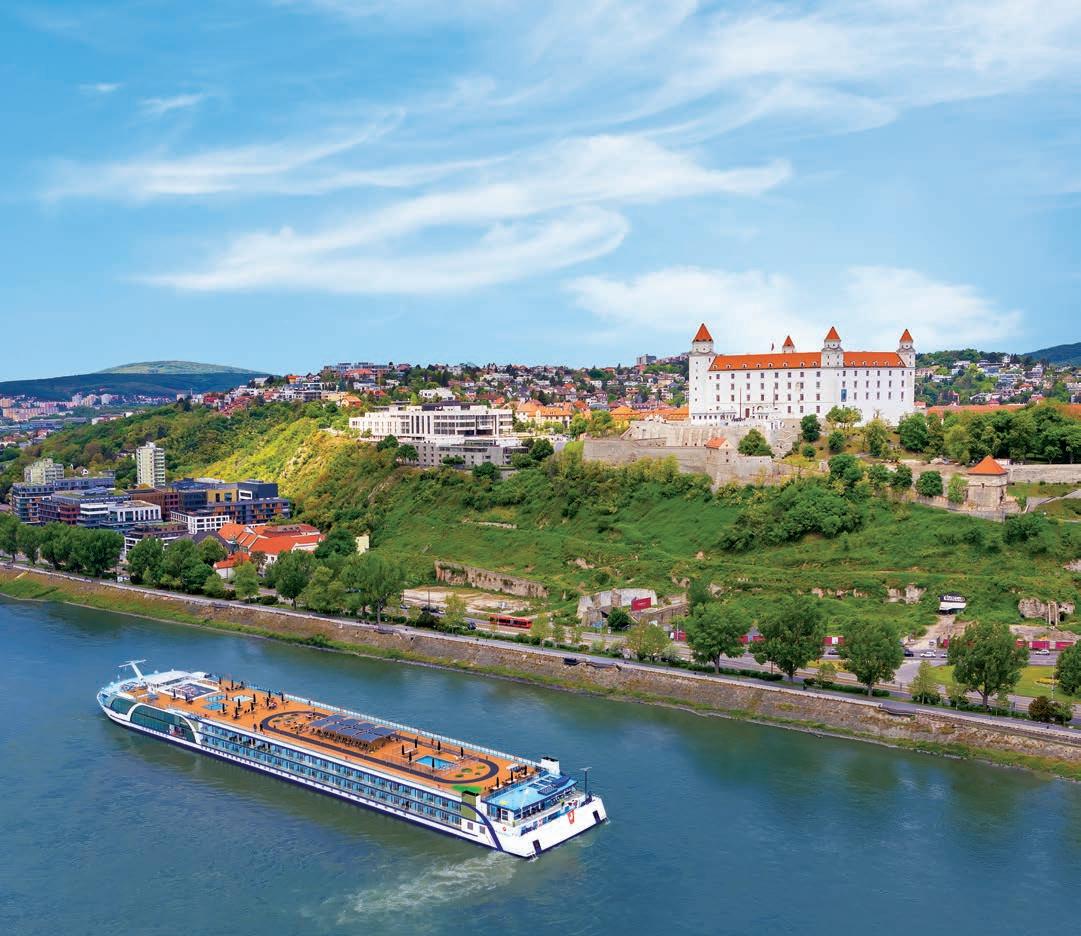



Experience the rich musical heritage of the “Blue Danube” with an array of included excursions on AmaWaterways’ Celebration of Music river cruises. Walk in the footsteps of renowned composers during guided tours in Budapest and Bratislava. Visit the historic Mozart residence in charming Salzburg and find inspiration during an evening of live music at one of Vienna’s elegant venues.
Contact your travel advisor or scan the QR code for dates and details.
Cast, performances, who’s who, director’s notes, donors and more.
Incident at Our Lady of Perpetual Help at North Coast Rep; The Importance of Being Earnest at Lamb’s Players Theatre; October concerts at Jacobs Music Center; San Diego Food + Wine Festival; and more.
A look inside San Diego and Tijuana’s dual designation as the World Design Capital 2024, distinguishing both as design-driven destinations.
The best recent films of Japan—Godzilla Minus One, Perfects Days and The Boy and the Heron—inspire a fascinating tour of Tokyo.
Performances’ new program platform for shows and concerts can be accessed from any digital device




































PUBLISHER
Jeff Levy
EDITOR
Sarah Daoust
ART DIRE CTOR
Carol Wakano
PRODUCTION MANAGER
Glenda Mendez
PRODUCTION ARTIST
Diana Gonzalez
CONTRIBUTING WRITERS
Benjamin Epstein, Stephanie Saad,
ADVERTISING DIRECTOR
Kerry Baggett
ACCOUNT DIRE CTORS
Walter Lewis, Jean Greene, Liz Moore
CIRCULATION MANAGER
Christine Noriega-Roessler
BUSINESS MANAGER
Leanne Killian Riggar
MARKETING/ PRODUCTION MANAGER
Dawn Kiko Cheng
DIGITAL PROGRAM MANAGER
Audrey Duncan Welch
DIGITAL MANAGER
Lorenzo Dela Rama
Contact Us
ADVERTISING
Kerry.Baggett@ CaliforniaMediaGroup.com
WEBSITE
Lorenzo.DelaRama@ CaliforniaMediaGroup.com
CIRCULATION
Christine.Roessler@ CaliforniaMediaGroup.com
HONORARY PRESIDENT
Ted Levy
For information about advertising and rates contact California Media Group 3679 Motor Ave., Suite 300 Los Angeles, CA 90034
Phone: 310.280.2880
Fax: 310.280.2890
Visit Performances Magazine online at socalpulse.com
Performances Magazine is published by California Media Group to serve performing arts venues throughout the West.
© 2024 California Media Group. All Rights Reserved.

At ProFiduciary, we are a team of financial, trust, and estate professionals who have spent decades building relationships with individuals and families to preserve their wealth and pass it on to loved ones and charitable institutions.







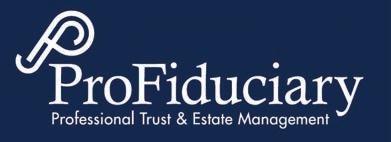

BROADWAY SAN DIEGO brings us two dynamic productions in October at the San Diego Civic Theatre: Kimberly Akimbo, winner of five Tony Awards, including “Best Musical,” Oct. 8-13; and SpiderMan Across the SpiderVerse, Live in Concert, Oct. 22-24. And save the date for the “hell-raising journey to the underworld and back” that is the Broadway smash and Tony- and Grammy-winning musical, Hadestown, which visits Nov. 8-10. Anaïs Mitchell’s haunting yet hopeful theatrical experience is performed by an electric ensemble cast of actors, singers and dancers. broadwaysd.com North Coast Rep in Solana Beach presents the San Diego premiere of Incident at Our Lady of Perpetual Help, Oct. 23-Nov. 17. The heartwarming comedy by Katie Forgette takes us back to the 1970s and inside the working-class family home of the O’Shea clan. northcoastrep.org At Lamb’s Players Theatre in Coronado, Oscar Wilde’s comic masterpiece, The Importance of Being Earnest, runs through Nov. 10. In this witty farce, two men assume the identity of a fictional man named Ernest, leading them to both fall in love. Shenanigans and hilarity ensue. lambsplayers.org
From left: Michael Louis Cusimano, Brian Mackey and Lauren King Thompson in The Importance of Being Earnest; the North American tour of Broadway’s Hadestown





Clockwise from far left: pianist Emanuel Ax; violinist Sergey Khachatryan; violinist Paul Huang; a scene from Giacomo Puccini’s timeless opera, La Bohème, which San Diego Opera presents at the San Diego Civic Theatre, Nov. 1-3.

IT’S A NEW era for the San Diego Symphony, which ushers in its 2024-25 season at its newly renovated concert hall: Jacobs Music Center. It’s set to host the popular Jacobs Masterworks Series and much more. October concerts include “The Romantic Lyricism of Schoenberg and Brahms,” featuring violinist Sergey Khachatryan,
Oct. 12-13; “Where We Lay Our Scene: A San Diego Symphony and Romeo and Juliet,” with pianist Emanuel Ax and other special guests, Oct. 18-20; and “Romantic Fates: Tchaikovsky’s Towering Fifth,” with violinist Paul Huang, Oct. 25-26. sandiegosymphony.org
Marking six decades of operatic excellence, the San Diego Opera
celebrates its 60th anniversary season by delivering three mainstage productions, accompanied by the San Diego Symphony Orchestra, at the Civic Theatre. The season opens with Puccini’s opera La Bohème, Nov. 1-3, taking us to 19th-century Paris, where a poor seamstress in declining health falls in love with a poet. sdopera.org
































THE CITY ROLLS out the red carpet for the San Diego International Film Festival, Oct. 16-20—showcasing more than 70 features, documentaries and short films by independent filmmakers across the globe. Presented by the San Diego Film Foundation, the festival marks its 23rd anniversary—“celebrating the power of film” with curated submissions from 3,200 filmmakers from 85 countries. The event lineup includes the Opening Night film premiere and reception at MOPA@ SDMA, Oct. 16; Night of the Stars Tribute at The Conrad, honoring some of the film industry’s more accomplished actors, directors and filmmakers, Oct. 17; film screenings at the AMC Theatres at Westfield UTC, Oct. 17-20; and Culinary Cinema on Oct. 20. sdfilmfest.com

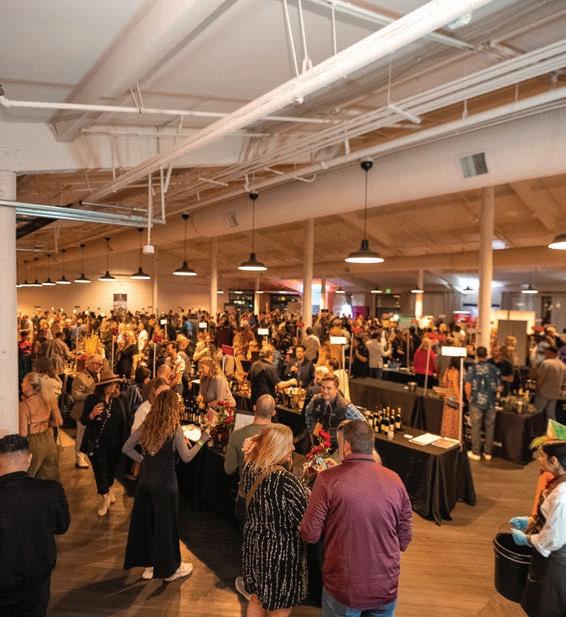
CALLING ALL FOODIES and oenophiles. Considered one of the premier culinary events in the U.S., the San Diego Food + Wine Festival returns Nov. 2-10, marking its 20th anniversary with a refreshed look and expanded programming. The event series (which tweaked its name from San Diego Bay Wine & Food Festival) has partnered with the James Beard Foundation and Food Tank this year to present experiences countywide that spotlight Latin, Asian and BIPOC culinary influences—with 175-plus chefs, vintners and industry leaders; plus 800 wines and spirits. Popular events like the Grand Fiesta (including the spirited Taco TKO competition) at Liberty Station’s Ingram Plaza and the Grand Tasting along the bayfront return; joined by new happenings like the Food Tank Summit, Friends of James Beard Foundation Opening Night & Grand Decant, Baja Culinary Expedition, and Culinary Cinema. sandiegowineclassic.com

SAN DIEGO AND TIJUANA SPOTLIGHTED AS A CULTURE-RICH, DESIGN-DRIVEN CROSS-BORDER DUAL DESTINATION by STEPHANIE SAAD

THE TWO CITIES OF SAN DIEGO AND TIJUANA, straddling one of the busiest border crossings in the world, are linked by so much more than geography. They share a history, a workforce and cultural connections; and what happens in one city inevitably affects the other. Throughout 2024, this connection has been recognized and celebrated by the cities’ joint designation as a World Design Capital, which culminates in a variety of events in the last months of the year.










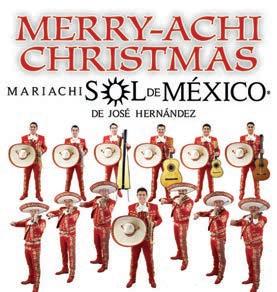


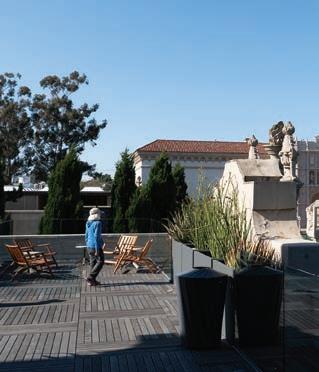
The World Design Organization, a Montrealbased non-governmental group comprised of more than 200 international design organizations, held its first World Design Capital (WDC) event in 2008. The event showcases how cities use design to reinvent themselves and improve their residents’ lives. Since 2008, WDC has been designated every other year to cities that include Seoul, South Korea; Helsinki, Finland; Cape Town, South Africa; Taipei, Taiwan; and Valencia, Spain. The WDC designation recognizes cities for their effective use of design to drive economic, social, cultural and environmental development. San Diego-Tijuana is the first binational, cross-border designation in WDC’s history and the first time a U.S. city has been selected for the


prestigious distinction.
“Both cities and the region bring unique strategic ways to solve problems through the lens of design,” says Tijuana-based graphic designer Katalina Silva, who was part of the group instrumental in bringing the WDC to San DiegoTijuana. “But not only that—design has a huge impact on the planet, and designers have a responsibility, in this complex region where we live, to find a way of co-living and collaborating to make life better for the people who live here; as well as for /CONTINUED ON PAGE 20

“A laugh-outloud comedy with a heartwarming touch.”
Embark on a delightful journey with the San Diego premiere of INCIDENT AT OUR LADY OF PERPETUAL HELP. Set against the vibrant backdrop of the 1970s, Katie Forgette’s charming comedy unfolds within the confines of a working class family home. The quirky O’Shea clan navigates the tumultuous and sometimes awkward realities of this rapidly changing decade. Join us for an unforgettable evening.
san diego premiere OCT 23-NOV 17
DIRECTED BY JENNY SULLIVAN
NORTHCOASTREP.ORG
box office (858) 481-1055
group sales (858) 481-2155, ext. 202

Dear friends,
This season will be remembered by all who are connected to The San Diego Symphony, and those who will walk through the Jacobs Music Center doors in the years to come. Now we will hear the first notes performed by the orchestra in our renovated indoor hall intended to be a destination for audiences well into the future.
Each time I have entered the hall in its progression toward its opening I have been struck by its history and its potential. It is timeless. The engineering that provides the infrastructure has stood the test of time and will support this building for decades to come. The original 1929 craftsmanship has been respected and lovingly restored by artisans of today. Our architects’ reimagining of the space will support an orchestra of today and tomorrow.
When I walk into this quiet space, I am overwhelmed by the anticipation of what is to come. Everyone who has had the opportunity to experience the hall in the months leading up to the reopening has been moved by the preservation of its storied past, and the refreshing of its spirit in and for the 21st century. They talk about the sense of calm and serenity with the beautiful sage green seats, the ornamental décor of the ceiling and walls, and the stunning medallion overhead. All give us moments of reprieve, stepping away from our outside world into a place where magic happens.

As always, our musicians will be at the center of the festivities, led by Music Director Rafael Payare. It is our privilage to sit in the stillness and anticipation of the first note all the way to the moment of slience after the last.
My deepest gratitude to all who have played your critical part in making this rebirth possible for today’s audiences and for all who will come after us. May they too find the magic within these walls.
Sincerely,

Martha A. Gilmer President and Chief Executive Officer
The San Diego Symphony Orchestra gratefully acknowledges the generous support of the following donors for their membership in the Partner with a Player program and their profound impact on the orchestra. Partner with a Player members enjoy the unique opportunity to personally connect with the orchestra and engage with the Symphony in meaningful ways.
The following listing reflects pledges and gifts entered as of August 8, 2024

$100,000 AND ABOVE
Raffaella and John◊ Belanich
Rafael Payare, Music Director
$50,000 – $99,999
Anonymous San Diego Symphony Musicians
Anonymous San Diego Symphony Musicians
Michele and Jules Arthur
Kevin Gobetz, Bass
Terry Atkinson
Igor Pandurski, Violin
John and Janice Cone
Benjamin Jaber, Principal Horn
Kevin and Jan Curtis
Aaron McCalla, Principal Tuba
Una Davis and Jack McGrory
Susan Wulff, Associate Principal Bass
Mr. and Mrs.◊ Brian K. Devine
San Diego Symphony Musicians
Phyllis and Daniel Epstein
Sheryl Renk, Principal Clarinet
Pam and Hal Fuson
Courtney Cohen, Principal Librarian
Elaine Galinson and Herbert Solomon
Yumi Cho, Violin
Carol and Richard Hertzberg
Nick Grant, Principal Associate Concertmaster Emeritus
Arlene Inch
John Degnan, Horn
Joan◊ and Irwin Jacobs
Martha Gilmer, Chief Executive Officer
Karen and Warren Kessler
Chi-Yuan Chen, Principal Viola
KAREN AND WARREN KESSLER CHAIR
Carol and George Lattimer
Gilbert Castellanos, Jazz @ The Jacobs and Jazz @ The Rady Shell Artistic Curator
Monica and Robert Oder
Gregory Cohen, Principal Percussion
Linda and Shearn◊ Platt
Ryan J. DiLisi, Principal Timpani
Marie Raftery and Dr. Robert Rubenstein
San Diego Symphony Musicians
Jaqueline and Jean-Luc Robert
San Diego Symphony Musicians
Elena Romanowsky
Edmund Stein, Violin
Penny and Louis Rosso
Andrew Watkins, Assistant Principal Timpani

Colette Carson Royston and Ivor Royston
Yeh Shen, Violin
Jean and Gary Shekhter
San Diego Symphony Musicians
Karen and Kit Sickels
Jeremy Kurtz-Harris, Principal Bass
SOPHIE AND ARTHUR BRODY FOUNDATION CHAIR
Karen Foster Silberman and Jeff Silberman
Jisun Yang, Assistant Concertmaster
Gayle◊ and Donald Slate
Wesley Precourt, Associate Concertmaster
Dave and Phyllis Snyder
Julia Pautz, Violin
Gloria and Rodney Stone
P.J. Cinque, Bass
Jayne and Bill Turpin
San Diego Symphony Musicians
Leslie and Joe Waters
Ethan Pernela, Viola

Sue and Bill◊ Weber
Jing Yan Bowcott, Violin
Kathryn and James Whistler
Rachel Fields, Librarian
Cole and Judy Willoughby
Christopher Smith, Principal Trumpet
Mitchell Woodbury
Douglas Hall, Horn
Sarah and Marc Zeitlin
Cherry Choi Tung Yeung, Associate Principal
Second Violin
Anonymous
Nathan Walhout, Cello
Annette and Daniel Bradbury
Yao Zhao, Principal Cello
Nikki A. and Ben G. Clay Symphony Cellist
Karen and Donald Cohn
Hanah Stuart, Violin
Stephanie and Richard Coutts
Chia-Ling Chien, Associate Principal Cello
Karin and Gary Eastham
Jason Karlyn, Viola
Anne L. Evans
San Diego Symphony Musicians
Lisette and Mick Farrell/ Farrell Family Foundation
Rose Lombardo, Principal Flute
$15,000 – $24,999
Anonymous
San Diego Symphony Musicians
Eloise and Warren Batts
Alicia Engley, Violin
Diane and Norman Blumenthal
Aaron Blick, Bass
Dr. Anthony Boganey
Logan Chopyk, Trombone
Julia R. Brown
Leyla Zamora, Bassoon and Contrabassoon
Dr. Carol Randolph and Robert Caplan, Seltzer Caplan
McMahon Vitek
Pei-Chun Tsai, Violin
Ann Davies
Xian Zhuo, Cello
Kathleen Seely Davis
Qing Liang, Viola
Ana de Vedia
San Diego Symphony Musicians
Hon. James Emerson
Kenneth Liao, Violin
Dr. Joyce Gattas and Mr. Jay Jeffcoat
San Diego Symphony Musicians
Kelly Magerman and Michael Greenleaf
Xiaoxuan Shi, Violin
Sandy and Arthur◊ Levinson
Kyle Covington, Principal Trombone
Lisa and Gary Levine, Arthur J. Gallagher & Co. San Diego Symphony Musicians
Eileen Mason
Julie Smith Phillips, Principal Harp
Anne and Andy McCammon
Richard Levine, Cello
Deborah Pate and John Forrest
Jeff Thayer, Concertmaster
DEBORAH PATE AND JOHN FORREST CHAIR
Allison and Robert Price
San Diego Symphony Musicians
Janet and Wil Gorrie
Zou Yu, Violin
Jill Gormley and Laurie Lipman
Frank Renk, Bass Clarinet
Judith Harris◊ and Dr. Robert Singer
Jonah Levy, Trumpet
Marilyn James and Richard Phetteplace
John Stubbs, Violin
Jo Ann Kilty
Tricia Skye, Horn
Helen and Sig Kupka
Lily Josefsberg, Piccolo/Flute
Dr. William and Evelyn Lamden
Andrea Overturf, Oboe
Carol Lazier and Dr. James Merritt
Sarah Tuck, Flute
Dr. Marshall J. Littman
John Lee, Cello
Sue and Lynn Miller
Max Opferkuch, Clarinet
Rena Minisi and Rich Paul
Ryan Simmons, Bassoon
Sally and Steve Rogers
Kyle Mendiguchia, Trombone
Marie Raftery and Dr. Robert Rubenstein
San Diego Symphony Musicians
Jeanette Stevens
Kathryn Hatmaker, Violin
Sandra Timmons and Richard Sandstrom
Sarah Skuster, Principal Oboe
Sheryl and Harvey White
Alexander Palamidis, Principal Second Violin
The Zygowicz Family (John, Judy, and Michelle)
Nancy Lochner, Viola
Val and Ron Ontell
Darby Hinshaw, Assistant Principal & Utility Horn
Jane and Jon Pollock
Evan Pasternak, Section Violin
Pamela and Stephen Quinn
San Diego Symphony Musicians
Sally and Steve Rogers
Kyle Mendiguchia, Bass Trombone
Cathy Robinson
San Diego Symphony Musicians
Stephen M. Silverman
Ai Nihira Awata, Violin
Elizabeth and Joseph◊ Taft
Wanda Law, Viola

Linda and Raymond◊ ThomasR.V. Thomas Family Fund
Ray Nowak, Trumpet
Julie & Stephen Tierney
San Diego Symphony Musicians
Isabelle and Mel◊ Wasserman
Andrew Hayhurst, Cello
For more information, or to join, please contact Vice President of Institutional Advancement, Sheri Broedlow at (619) 615-3910 or sbroedlow@sandiegosymphony.org.
David R. Snyder, Esq. Chair of the Board*
Harold W. Fuson Jr. Immediate Past Chair*
Colette Carson Royston Vice Chair*
Una Davis Vice Chair*
David Bialis Treasurer*
Linda Platt Secretary*
Michele Arthur
Tim Barelli
Lisa Behun*
Anthony C. Boganey, M.D., FACS
Julia R. Brown*
Mary Casillas Salas
Ben G. Clay
Kathleen Davis*
Martha G. Dennis, Ph.D.
Phyllis Epstein*
Lisette Farrell
Karen Foster Silberman
Janet Gorrie
Dr. Irwin M. Jacobs
Joan K. Jacobs (1933-2024)
Warren O. Kessler, M.D.
Anne Francis Ratner (1911-2011)
Lawrence B. Robinson (d. 2021)
Warren O. Kessler, M.D. Chair
David R. Snyder, Esq. Vice Chair
Sandra Levinson Secretary
Mitchell R. Woodbury Treasurer
2021-23 Harold W. Fuson Jr.
2018-21 David R. Snyder, Esq.
2015-18 Warren O. Kessler, M.D.
2014-15 Shearn H. Platt
2011-14 Evelyn Olson Lamden
2009-11 Mitchell R. Woodbury
2008-09 Theresa J. Drew
2007-08 Steven R. Penhall
2005-07 Mitchell R. Woodbury
2004-05 Craig A. Schloss, Esq.
2003-04 John R. Queen
2001-03 Harold B. Dokmo Jr.
2000-01 Ben G. Clay
1998-00 Sandra Pay
1995-96 Elsie V. Weston
Robert Caplan, Esq.
Harold W. Fuson Jr.
Martha Gilmer
Susan Mallory
Jeremy Pearl
Mark Stuart
Dr. Nancy Hong
Arlene Inch
Jerri-Ann Jacobs
Warren O. Kessler, M.D.*
Kris Kopensky
Deborah Pate
Alan Prohaska
Sherron Schuster
Marivi Shivers
Christopher D. “Kit” Sickels
Donald M. Slate*
Gloria Stone
Frank Vizcarra
Mitchell R. Woodbury*
*EXECUTIVE COMMITTEE MEMBER
Herbert Solomon Mitchell R. Woodbury
1994-95 Thomas Morgan
1993-94 David Dorne, Esq.
1989-93 Warren O. Kessler, M.D.
1988-89 Elsie V. Weston
1986-88 Herbert J. Solomon
1984-86 M.B. “Det” Merryman
1982-84 Louis F. Cumming
1980-82 David E. Porter
1978-80 Paul L. Stevens
1976-78 Laurie H. Waddy
1974-76 William N. Jenkins, Esq.
1971-74 L. Thomas Halverstadt
1970-71 Simon Reznikoff
1969-70 Robert J. Sullivan
1968-69 Arthur S. Johnson
1966-68 Michael Ibs Gonzalez, Esq. 1964-66 Philip M. Klauber
1963-64 Oliver B. James Jr. 1961-63 J. Dallas Clark
1960-61 Fielder K. Lutes
1959-60 Dr. G. Burch Mehlin
1956-58 Admiral Wilder D. Baker
1953-56 Mrs. Fred G. Goss
1952-53 Donald A. Stewart
1940-42 Donald B. Smith
1938-39 Mrs. William H. Porterfield
1934-37 Mrs. Marshall O. Terry
1930-33 Mouney C. Pfefferkorn
1928-29 Willett S. Dorland
1927 Ed H. Clay

With his innate musicianship, charismatic energy, gift for communication, and irresistibly joyous spirit, Venezuelan conductor Rafael Payare is “electrifying in front of an orchestra” (Los Angeles Times). Payare conducted the San Diego Symphony (SDS) for the first time in January 2018 and was subsequently named the orchestra’s music director designate one month later, before assuming the role of music director in January 2019.
Now in the sixth season of his transformative tenure as music director of the San Diego Symphony, Payare will conduct a full roster of performances with the orchestra at the newly renovated Jacobs Music Center over the 2024-25 season, bookended by Mahler’s Second and Third Symphonies. Last season, Payare led the SDS for its first appearance in a decade at Carnegie Hall, its first performance in Tijuana in nearly 20 years, and in three programs at the inaugural California Festival. These engagements continued his transformative tenure with the orchestra, which also included their commercial album debut with Shostakovich’s 11th Symphony, The Year 1905.
Payare’s other recent highlights include debuts at the Royal Opera House, at the Edinburgh Festival, and with the New York Philharmonic, San Francisco Symphony, Orchestre national de France, and Staatskapelle Berlin, with which he reunited for Turandot at the Berlin State Opera this past summer.
The 2024-25 season also marks his third as Music Director of Canada’s Orchestre symphonique de Montréal (Montreal Symphony Orchestra/OSM). With the OSM he leads a similarly full season in
Montreal, tours to eight European cities with pianist Daniil Trifonov, and releases his third album with the orchestra on the Pentatone label—an all-Schoenberg recording to mark the composer’s 150th anniversary. The conductor rounds out his season with high profile returns to the New York Philharmonic, The Philadelphia Orchestra, and London’s Royal Opera House, Covent Garden.
Other current positions are Principal Conductor of Virginia’s Castleton Festival, a post he has held since 2015, and Conductor Laureate of Northern Ireland’s Ulster Orchestra, where he was Principal Conductor and Music Director from 2014 to 2019, making multiple appearances at London’s BBC Proms.
Since winning first prize at Denmark’s Malko Competition for Young Conductors in 2012, Payare has made debuts and forged longstanding relationships with many of the world’s preeminent orchestras. His U.S. collaborations include engagements with the Boston Symphony, Chicago Symphony, Cleveland Orchestra, Houston Symphony, Los Angeles Philharmonic, Minnesota Orchestra, Philadelphia Orchestra, and Pittsburgh Symphony, while his notable European appearances include dates with the Bavarian Radio Symphony, Leipzig Gewandhaus Orchestra, London Symphony Orchestra, Mahler Chamber Orchestra, Munich Philharmonic, NDR Elbphilharmonie Orchestra, Orchestre Philharmonique de Radio France, Philharmonia Orchestra, Royal Stockholm Philharmonic, Tonhalle Orchestra Zurich, and Vienna Philharmonic, which he has led at the Vienna Konzerthaus and Musikverein, on a Baltic tour, and at Paris’s Théâtre des Champs-Élysées. n

FRIDAY, OCTOBER 4 7:30 PM
SATURDAY, OCTOBER 5 7:30 PM
SUNDAY, OCTOBER 6 2 PM
Jacobs Music Center
2024 JACOBS MASTERWORKS
Rafael Payare, conductor
Angela Meade, soprano
Anna Larsson, mezzo-soprano
San Diego Symphony Festival Chorus
Andrew Megill, advisor & chorus master
San Diego Symphony Orchestra

THOMAS LARCHER
Time, Three Movements for Orchestra
Co-commissioned by the San Diego Symphony
Moderato
�� = c. 66
Andante -INTERMISSION-
MAHLER
Symphony No. 2 in C minor, Resurrection
Allegro maestoso
Andante moderato
In ruhig fliessender Bewegung
Urlicht (Primeval Light)
Im Tempo des Scherzo
Angela Meade, soprano
Anna Larsson, mezzo-soprano
San Diego Symphony Festival Chorus
Total Program Duration: 2 Hours 5 Minutes (includes one, 20-minute intermission).
See bio on page P5.

American soprano Angela Meade is the winner of both the Metropolitan Opera’s 2012 Beverly Sills Artist Award and the 2011 Richard Tucker Award. In 2008 she joined an elite group of history’s singers when, as Elvira in Verdi’s Ernani, she made her professional operatic debut on the Met stage. Since then she has fast become recognized as one of today’s outstanding vocalists, excelling in the most demanding heroines of the 19th-century bel canto repertoire as well as in the operas of Verdi and Mozart.
In the 2024/2025 season, Angela Meade makes notable returns to Teatro La Fenice, The Metropolitan Opera, Bayerische Staatsoper, and Teatro Carlo Felice in celebrated role portrayals. She returns to the Metropolitan Opera as Leonora in Il Trovatore in David McVicar’s critically acclaimed production, conducted by Daniele Callegari. She sings the title role in Lucrezia Borgia in Munich, and makes her role debut as the title role in Die Liebe der Danae at Teatro Carlo Felice with Fabio Luisi. Concert appearances include Mahler 8 with Nashville Symphony and Mahler 2 with San Diego Symphony and Rafael Payare.
Last season, Meade returned to the Metropolitan Opera for Amelia in Un Ballo in Maschera conducted by Carlo Rizzi. She sang the title role in Ermione with Washington Concert Opera alongside Lawrence Brownlee and David Portillo, followed by her role debut as Chrysothemis in Elektra at Dallas Opera. She sang the title role in Beatrice di Tenda at Teatro Carlo Felice and joined Teatro La Fenice for the Verdi Requiem. In the spring, she joined LA Opera for her role debut in the title role of Turandot conducted by James Conlon in the celebrated production by David Hockney, reprising the role later with Teatro dell’Opera di Roma at The Baths of Caracalla.
The season prior, Angela Meade made her Teatro alla Scala debut singing Elena in I Vespri Siciliani conducted by Fabio Luisi and made her role debuts in the title role of Lucrezia Borgia in her house debut at Bayerische Staatsoper, and as Leonora in La Forza del Destino with Amigos de la Ópera de A Coruña in A Coruña, Spain. She joined Amigos de la Ópera de A Coruña again for their 70th anniversary gala, and returned to Asociación Bilbaína de Amigos de la Ópera (“ABAO”) in Bilbao to perform the title role in Act III of Aida in concert. She returned to the Metropolitan Opera for Elisabeth de Valois in Sir David McVicar’s production of Don Carlo conducted by Carlo Rizzi and returned to Teatro Regio di Torino for the Verdi Requiem. Following her debut at La Scala, she sang the title role in Aida in Torino and at the Metropolitan Opera, the title role in Norma at the Metropolitan Opera, Lucrezia Contarini in I Due Foscari at Teatro Carlo Felice, and Elvira in Ernani at Palau De Les Arts Reina Sofia. n

ANNA LARSSON
Swedish Court Singer Anna Larsson made her international debut in 1996 singing Mahler’s Second Symphony with the Berliner Philharmoniker and Claudio Abbado. She has sung with the Wiener Philharmoniker, London Symphony and London Philharmonic Orchestras, Orchestre Philharmonique de Radio France, Lucerne Festival Orchestra, New York Philharmonic Orchestra, Los Angeles Philharmonic Orchestra, Chicago Symphony, NHK Symphony Orchestra Tokyo and Accademia di Santa Cecilia in Rome with conductors including Daniel Barenboim, Sir Simon Rattle, EsaPekka Salonen, Vladimir Jurowski, Adam Fischer, Zubin Mehta, Gustavo Dudamel, Daniel Harding, Antonio Pappano and Herbert Blomstedt. She is renowned for her interpretation of Mahler and regularly sings his 2nd and 3rd symphonies and song cycles. Other concert repertoire includes Beethoven Missa Solemnis, Elgar The Dream of Gerontius, Bach Oratorios, Brahms Alto Rhapsody, Wagner Wesendonck Lieder, Schönberg Gurrelieder and much contemporary repertoire. She has been a frequent guest at the festivals of Aix-en-Provence, Salzburg, the BBC Proms, Lucerne Festival and Verbier Festival, and created the Dalecarlia festival in Sweden.
On the operatic stage she has sung Erda in Rheingold and Siegfried, Waltraute in Götterdämmerung and Klytaimnästra in Elektra at the Wiener Staatsoper, the latter also at the Deutsche Oper Berlin in 2022, Erda in Rheingold and Siegfried, Genevieve in Pelleas and Kundry in Parsifal at the Deutsche Staatsoper Berlin. Elsewhere she has sung Zia Principessa in Suor Angelica at the Royal Opera House, Covent Garden, Royal Opera Stockholm, and at Malmö Opera and Oslo Opera this season, and Genevieve/Pelleas et Melisande at the Salzburg Festival and Opera National de Paris.
At Teatro alla Scala Milan Anna sang Erda /Rheingold and Siegfried and Mahler’s Second Symphony with Gustavo Dudamel. She also sang Mistress Quickly in Frankfurt, Gluck Orfeus at the Royal Opera Copenhagen and Dalila/ Samson and Dalila at the Royal Opera Stockholm. She is widely represented in recordings both in opera and concert. A committed teacher and mentor, Anna regularly gives masterclasses, especially in universities throughout Sweden and internationally. She is a member of the Swedish Royal Academy of Music and was made a Swedish Court Singer and awarded two gold medals from the King of Sweden for her contributions as an artist and to Swedish culture through the Dalecarlia Festival. n
Adam Boocher, Bass
Aeria Chang, Soprano
Amanda Olea, Soprano
Amy Long, Soprano
Antonia Fuenzalida, Alto
April Fisher, Soprano
Becca Ung, Alto
Bella Son, Alto
Braden Pontoli, Tenor
Breanne Espinosa, Alto
Brian Byun, Tenor
Carlos Lewis, Tenor
Carly Cummings, Soprano
Carole Crocco, Soprano
Caroline Nelms, Soprano
Chase Lowary, Bass
Christian Durini, Bass
Christian Liu, Alto
Christopher Walters Bass
Cindy James, Alto
Danny Johnson, Tenor
Elda McGinty Peralta, Alto
Elizabeth King, Soprano
Emma Pinkerton, Alto
Enluis Montes Olivar, Tenor
Eric Drimmer, Bass
Erica Moss, Alto
Evangelina Woo, Alto
George Arcaina, Tenor
Gerald Shenk, Tenor

Gonzalo Ochoa Camarena, Tenor
Greg Frank, Bass
Hayley Woldseth, Alto
Ian Schipper, Bass
Iana Peralta, Soprano
Isabella Panagiotou, Soprano
Isabella Fine, Soprano
Ivy Bernhardson, Soprano
Jack Adkins, Tenor
Jade Popper, Soprano
James Shelley, Tenor
Jane Shim, Alt
Janet White, Soprano
John Polhamus, Bass
Jose Ruiz, Tenor
Joseph Argus, Tenor
Joshua Read, Bass
Karen Erickson, Alto
Kathleen Moriarty, Alto
Kelsey Fahy, Alto
Kevin Williams, Tenor
Kit Jack Chan, Tenor
Krista Wilford, Soprano
Kseniya Orlik, Soprano
Kyuyim Lee, Soprano
Laura Richwood, Alto
Laurelle Stuart, Alto
Lauren Rossen, Soprano
Lauren Zinke, Soprano
Lola Watson, Soprano
CHORUS DIRECTOR:
ANDREW MEGILL
Andrew Megill is professor of conducting and director of choral organizations at the Northwestern University Bienen School of Music, where he holds the Carol F. and Arthur L. Rice, Jr. University Professorship in Performance. In addition, he leads Music of the Baroque Chorus, the Montreal Symphony Orchestra Chorus, the Carmel Bach Festival Chorale, and Fuma Sacra.
Megill is recognized as one the leading choral conductors of his generation, admired for both his passionate artistry and his unusually wide-ranging repertoire, which extends from early music to newly composed works. He has prepared choirs for the American Composers Orchestra, American Symphony, Cleveland Orchestra, Dresden Philharmonie, National Symphony, New Jersey Symphony, New York Philharmonic, and Venice Baroque Orchestra for conductors including Pierre Boulez, Charles Dutoit, Joseph Flummerfelt, Rafael Frühbeck du Burgos, Alan Gilbert, Neeme Järvi, Zdenek Macal, Kurt Masur, Zubin Mehta, Kent Nagano, John Nelson, Rafael Payare, and Julius Rudel. Recordings of choirs conducted or
Malachi Marshall, Bass
Marcia Banks, Soprano
Mary Boles Allen, Alto
Megan Jones, Alto
Melody Olvera, Bass
Meri Rogoff, Soprano
Nathan Villamor, Bass
Nicole Avakyan, Soprano
Nicole Bird, Alto
Nicole Taylor, Soprano
Noah Friedman, Tenor
Patrick McLaughlin, Bass
Paul Chen, Bass
Pierre Tang, Tenor
Rachel Fields, Soprano
Rick Roesler, Bass
Samuel Buse, Tenor
Sara Frondoni, Soprano
Sarah-Nicole Carter, Alto
Sean Smith, Bass
Susan Marberry, Alto
Theodora Mautz, Alto
Tim McLellan, Bass
Tony Malerich, Tenor
Trent Biggs, Bass
Walter DuMelle, Bass
William Propp, Bass
Zachary Kurzenberger, Bass
Zlatoslav Sokolov, Bass
prepared by him may be heard on the Decca, EMI, Canteloupe, Naxos, Albany, and CBC labels.
Megill is particularly admired for his performances of Baroque choral works. He regularly collaborates with leaders in the field of historically-informed performance, and has conducted many periodinstrument orchestras, including Piffaro, Rebel, Sinfonia NYC, Brandywine Baroque, the Sebastians, Tempesta di Mare, and the Trinity Baroque Orchestra. A frequent champion of music of our own time, he has also conducted regional or world premieres of works by Caleb Burhans, Paul Chihara, Dominic DiOrio, Sven-David Sandström, Caroline Shaw, Lewis Spratlan, Steven Stucky, Jon Magnussen, Arvo Pärt, and Krzysztof Penderecki.
Prior to his appointment at Northwestern, Megill served as professor and director of choral activities at the University of Illinois (Urbana-Champaign) and taught at Westminster Choir College for more than 20 years. He also previously served as music director of the Masterwork Chorus and Orchestra and Chorusmaster for the Spoleto Festival USA. He has been a guest artist with the Yale Institute of Sacred Music, TENET vocal ensemble, the Juilliard Opera Center, and Emmanuel Music, and served as interim choirmaster for Trinity Church in Manhattan.
Born September 16, 1963, Innsbruck, Austria
APPROXIMATE PERFORMANCE TIME 22 MINUTES
Thomas Larcher grew up in Austrian and studied piano and composition in Vienna. He made his career at first largely as a pianist, but over the last twenty years he has concentrated on composing. A prolific composer, Larcher has written one opera (The Hunting Gun, 2018), numerous works for orchestra, five string quartets and music for piano. He has shown a particular facility in writing for voice and has composed numerous song cycles, many written specifically for the talents of individual singers. Larcher was the featured composer of the BBC Symphony’s 2018-19 season, and he is currently composer-in-residence with the Concertgebouw Orchestra in Amsterdam.
Larcher composed Time in 2022 on a joint commission from the Montreal Symphony Orchestra, San Diego Symphony, NDR Radio Philharmonie, Netherlands Philharmonic and Tonkünstler Orchester. Rafael Payare led the world premiere with the Montreal Symphony on September 14, 2022, and the American premiere with the San Diego Symphony on November 12, 2022. In the published score, Larcher has provided a brief introduction to Time:
Every piece of music takes time into calculation. There are millions of ways to do that, but it always has to be done. Here, the treatment of time has been an underlying concept: Form is established through tensions evoked by ‘changing’ time (seemingly prolonging or compressing it) rather than motivic or even harmonic development. The treatment of rhythm has also been determined by sensing what a listener is really able to hear, to digest in a tiny or large amount of time. Thinking about time intensely has provoked a form which is open, as a piece of music can only ever be a cutout of ever-flowing time.
-Thomas Larcher
Time is in three inter-connected movements that span a total of about twenty minutes. It is scored for a very large orchestra that calls for three percussionists, who play an incredible array of instruments, including waterphone, sandblocks, thundersheet, cowbell, Chinese cymbals, wooden board, paper of various weights, and all manner of drums and woodblocks, to name only a few. In addition, Larcher calls for a prepared piano and double-basses that can tune their lowest string down to an A.
Given the title of this work, listeners should be alert to the many ways time is “expressed” here. At the most obvious level, this involves an almost constant “ticking” in the background. This ticking can be very subtle and quiet,
and it can also be overpowering, but a staccato pulse beats through much of this piece. Another expression of time comes in this music’s readiness to leap between different meters. Still another can be felt in Larcher’s subtle adjustment of tempo within movements, and yet another arises from the superimposition of different pulses (3 against 2, among many).
In his introduction, Larcher states that “a piece of music can only ever be a cutout of ever-flowing time,” and so we should listen not just for a metronomic accompaniment or shifts of meter but also for the “music” that occurs within this “cutout of every-flowing time.” For all this music’s metronomic obsession, it also offers some lovely thematic material. (The opening theme of the final movement, scored for clarinets and cellos, is only one of many examples.) Every listener will feel that time is explored in different ways in this music, as it makes its way from the subtle beginning through great waves of sound and color (and rhythm!) and finally to a surprisingly subdued conclusion. n
GUSTAV MAHLER
Born July 7, 1860, Kalischt, Bohemia
Died May 18, 1911, Vienna, Austria
APPROXIMATE PERFORMANCE TIME 1 HOUR 30 MINUTES
In 1888 Gustav Mahler, then 28 years old, was well-known as the talented second conductor of the Leipzig Opera but almost unknown as a composer: he had completed his First Symphony the year before, but that music remained in manuscript, unperformed. While

at Leipzig, Mahler began composing a new work, a huge symphonic movement. Always the most superstitious of composers, Mahler was assailed as he conceived the new work by visions of himself lying dead on his own bier, surrounded by funeral wreaths. He completed this long and dramatic movement in August 1888 and named it Todtenfeier: “Funeral Rite.” But – unsure how to proceed after so vast a beginning – Mahler set the work aside for five years.
He took it up again in the summer of 1893. Using Todtenfeier, now much revised, as a first movement, he composed second and third movements but could not decide how to conclude the work, and once again he set it aside. It was at a memorial service for conductor Hans von Bülow in March 1894 that Mahler heard a chorus sing the hymn Auferstehung (“Resurrection”) on a text by the German poet Friedrich Klopstock. At the moment he heard the chorus, Mahler felt his ideas for the conclusion of his symphony take shape – “It struck me like lightning, this thing, and everything was revealed to my soul clear and plain” – and quickly sketched the fourth and fifth movements, completing the symphony in 1894. Mahler conducted a performance of the first three movements in March 1895 and then of the entire symphony in December of that year. After a creative process lasting six years, the Second Symphony was finally presented to the public.
But that public had difficulty understanding the new work, which lasts eighty minutes and requires two soloists, a huge chorus and a gigantic orchestra. At the request of a young admirer who had been mystified by the symphony, Mahler drew up a program for it. He wrote of the first three movements:
I have named the first movement “Todtenfeier”… there is the great question: “Why did you live? Why did you suffer? Is it all nothing but a huge, frightful joke?” We must answer these questions in some
way, if we want to go on living – indeed, if we are to go on living! He into whose life this call has once sounded must give answer; and this answer I give in the final movement.
The second and third movements are conceived as an interlude. The second is a memory – a shaft of sunlight from out of the life of this hero. It has surely happened to you, that you have followed a loved one to the grave, and then perhaps, on the way back, there suddenly arose the image of a long-dead hour of happiness, which now enters your soul like a sunbeam that nothing can obscure – you could almost forget what has just happened. That is the second movement.
But when you awake from this wistful dream, and have to return into the confusion of life, it can easily happen that this ever-moving, never-resting, never-comprehensible bustle of existence becomes horrible to you, like the swaying of dancing figures in a brightly-lit ballroom, into which you look from the dark night outside – and from such a great distance that you can no longer hear the music. Life strikes you as meaningless, a frightful ghost, from which you perhaps start away with a cry of disgust. This is the third movement…
For a later performance, Mahler described the final movements:
Fourth movement: the morning voice of ingenuous faith strikes on our ears. Fifth movement: we are confronted once more with terrifying questions. A voice is heard crying aloud: “The end of all living things is come – the Last Judgment is at hand”… the trumpets of the Apocalypse ring out; in the eerie silence which follows, we can just catch the distant, barely audible song of a nightingale, a last tremulous echo of earthly life. A chorus of saints

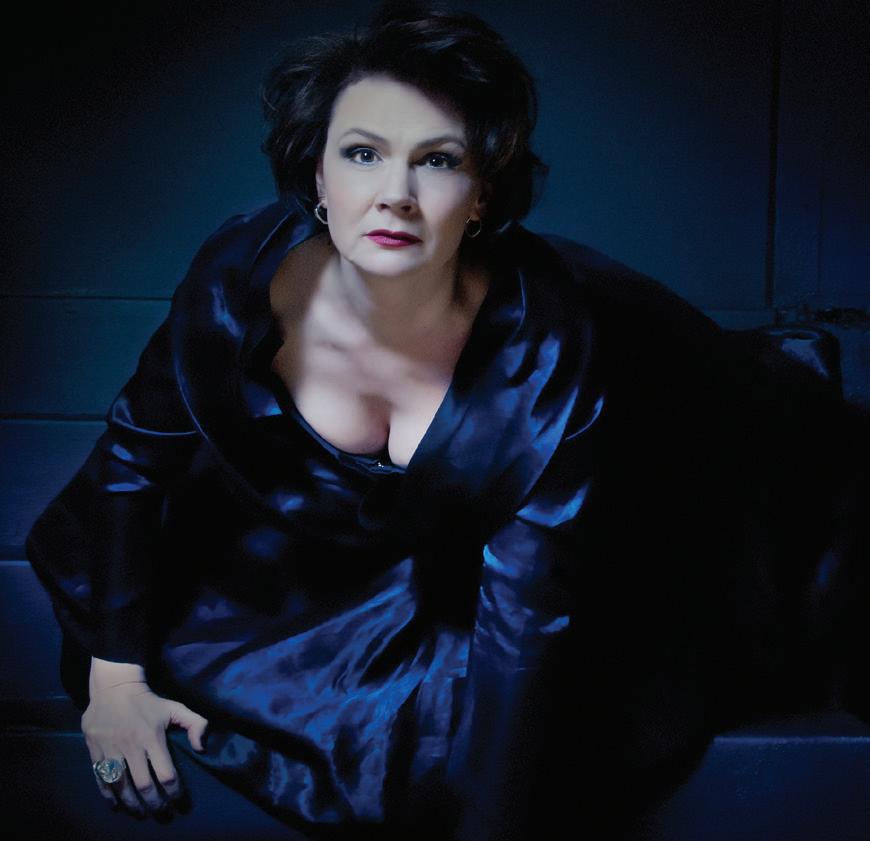
and heavenly beings softly breaks forth: “Thou shalt arise, surely thou shalt arise.” Then appears the glory of God: a wondrous soft light penetrates us to the heart – all is holy calm.
And behold, it is no judgment; there are no sinners, no just. None is great, none small. There is no punishment and no reward. An overwhelming love illuminates our being. We know and are.
But Mahler quickly withdrew this program, denouncing it as “a crutch for a cripple” and claiming that it gave only “a superficial indication” of the meaning of the symphony.
What sense, then, are we to make of Mahler’s elaborate program for his Second Symphony? Does it tell us what the symphony is “about”? Well, sort of. Mahler may have disavowed the verbal program, but the symphony does move from a death-haunted opening movement to resurrection in the finale, and the last two movements present texts that conform to and conclude Mahler’s program. The “meaning” of this symphony, however, does not lie in Mahler’s verbal description or even in the texts sung in the final movement, but in the entire music-drama itself, which cannot be reduced to simple verbal explanation. The music takes us where words cannot: it creates its own vast and dramatic world, one that deals with violent and terrifying issues, full of pain, terror and ecstasy.
For his model for this symphony, Mahler took one of the most imposing creations in music – Beethoven’s Ninth Symphony – in which three instrumental movements are followed by a choral finale that addresses a grand philosophical question. Mahler seems to be trying to out-do Beethoven, particularly in the vastness of his conception and the huge forces he employs: the Resurrection Symphony requires quadruple woodwind, ten horns, eight trumpets, four trombones, two harps and a huge percussion battery.
The opening Allegro maestoso is one of Mahler’s most dramatic creations, in darkest C minor and enveloped at times in furious violence. It is in sonata form only in the most general of senses, opposing material of ear-splitting violence with passages of luminous, rapturous calm. At its end, a grim funeral tread pushes the movement toward a final cataclysm before the movement vanishes on barelyaudible pizzicato strokes.
After so violent an opening, the next movement seems an island of calm. It is a ländler, the ancient Austrian country dance, and it breathes a sort of nostalgia: “some lingering resonance of long past days,” said Mahler. The third movement has a more sinister air. It is a kind of perpetual-motion scherzo in which ghostly music presses continually ahead, erupting at times in grotesque humor. Mahler based this movement on his own song “Saint Anthony of Padua’s Sermon to the Fishes,” in which the fish patiently hear out the sermon and then resume their sinful ways. The bitter humor of that song flows through this movement, and Mahler underlines this with some wonderful scoring, including the use of the Rute (a bundle of wooden twigs beaten on the back of the bass drum), a squealing E-flat clarinet, and an ominous close on a tam-tam stroke.
The brief fourth movement functions as a transition away from issues of life and death and toward resurrection. The mezzo-soprano soloist sings Mahler’s setting of the German folk poem “Urlicht” (“Primal Light”), composed two years earlier, and her song leads us toward the finale: “I am from God and to God would I return!”
By far the longest of the five movements, the finale is virtually a piece of musical theater, depicting nothing less than a progression from the day of judgment to resurrection and requiring performers to move off and on stage, incorporating sounds that range from delicate birdcalls to the crack of doom, and employing a massive chorus in its final minutes. Like the opening of the last movement of Beethoven’s Ninth, the finale of the Resurrection Symphony explodes, in this case with Mahler’s vision of the day of judgment. The long instrumental beginning presents a harrowing vision of that day, full of offstage brass calls and a propulsive march based on the ancient Dies Irae motif: in Mahler’s words, “The earth quakes, the graves burst open, the dead arise and stream on in endless procession… their cry for mercy, for grace, strikes fearfully on our ears.” Finally, with the fury of Judgment Day spent, the sound of the nightingale floats above the trembling air and the chorus begins to sing Klopstock’s Resurrection hymn with its message of rebirth and eternal life. Mahler, however, adds several verses of his own to the Klopstock, and these (beginning “O glaube”) sharpen the text, suggesting that life does not pass in vain, but that one can find meaning in earthly acts and still receive eternal life. As the souls make their passage to eternity, the Resurrection Symphony concludes with ringing brass and pealing bells, a triumphant sound that should rise up to shake the heavens. n
-Program note by Eric Bromberger

The poet Goethe once told a friend:
“I’ve found a page among my papers where I describe architecture as ‘frozen music’. There’s something in that, you know. The state of mind produced by architecture is similar to the effect of music.”
Goethe was putting his finger on something even more important than he himself knew.
Two centuries later, Paul Scarbrough, the inspired creator of the amazing acoustic of our wonderful San Diego Symphony Orchestra’s new Jacobs Music Center, puts it this way: Music – and especially symphonic musicis made from a dialogue between the musicians and the room.
What does Paul mean? Too often in our lives today we experience music as something fixed, recorded, digitally preserved, and possible to replay in exactly the same way at the push of a button and an endless number of times.
But that’s not what live music is. And especially not symphonic music.
Live music is not a dead object, but a living experience, fluid, always different, endlessly changing. A recording of a great musical performance is like a photograph of a great painting or a fabulous waterfall in the mountains. It’s beautiful, but it is not the same as the live experience. So, what happens when we hear live music in a great hall – or ‘room’, as Paul Scarbrough calls it?
The room is an almost magical construction: it’s made, on the one hand, of the air contained within it, which vibrates as we send sounds through it; and on the other, of the array of walls and surfaces which surround and contain that air, some flat, some curved, some porous, some hard, some soft.
When a musician plays a note, the vibrations of that note fly out in waves towards the surrounding surfaces and are then thrown back in an almost infinite variety of different
ways. And on their way back these waves meet other waves and other vibrations coming in the opposite direction, and all these waves mix and combine in a thousand different ways. Like the gorgeous colors of a sunset or the shimmering of the ocean.
It’s like a pond. You throw a pebble into it and the ripples expand in every direction and meet other ripples coming in the opposite direction. And the combination of all these ripples is always changing and in motion, never fixed and never the same. It is a living thing.
A musician who throws a sound – an acoustic ‘pebble’ – into the beautiful vibrating space of a great room like the Jacobs Music Center can change that sound in an almost infinite number of ways. Not just by making it louder or softer, but by altering the colors and the textures, using their breath, their fingers and their ears. By using, in other words, their bodies and their imaginations (and maybe those two things are actually the same!).
And that’s just one musician.
Now take a symphony orchestra. Let’s say, 80 musicians or thereabouts. Each is throwing pebbles of sound into the air. Acoustic waves in the most dazzling combinations are flying about in every direction.
But orchestral musicians are doing a lot more than that, every second listening to one another, and changing – from moment to moment – what they do in order to combine in a thousand different ways with the endlessly kaleidoscopic waves being created in real time by their colleagues all around them.
So, listening to a symphony orchestra is like watching a vast flock of birds swirling through the sky. Or – as the Ancient Greeks thought we could actually do – hearing the stars and planets revolving in the cosmos.
That’s why every live performance of a piece of music is and should always be completely different and unique. In a hall like ours, you could hear Beethoven’s Fifth Symphony a hundred times and every time it would sound in a new way. And we, the listeners, would hear the ‘same music’ in a different way.
And that brings us to the most important element in a great hall: the audience.
Paul Scarbrough’s ‘dialogue’ is actually a ‘trialogue’, made up of the room and its vibrating air and surfaces; the musicians and the thousands of notes that they are playing; and the rest of us sitting in the audience and listening with our whole bodies. For, live music is nothing without an audience. And listening is never just a passive experience (‘letting the music wash over us’) but an active experience from every point of view. It starts with the imaginative creation by Paul Scarbrough and his team of this world-class new

acoustic space in the Jacobs Music Center. It continues with the imaginative response of the musicians of the San Diego Symphony Orchestra as they play to the room and the room speaks back to them (you might call this a dance between the musicians and the hall). And then comes our imaginative physical and emotional response in the audience to this endlessly changing acoustic life flowing around us. From that come the joys we feel, the tears we shed, as we listen.
And this living and reciprocal play and movement of sound doesn’t even stop there. For as the musicians hear how we are listening, they will change the way they play in order to respond to us. And then the air and surfaces of the new hall will change to respond to them, in yet more ways that no one could have predicted.
Two and half thousand years ago, an Ancient Greek philosopher is supposed to have said:
“All things are in motion and nothing is at rest. You cannot step into the same river twice.” n
— Gerard McBurney

Douglas Hall has enjoyed many adventures in good music here with the San Diego Symphony Orchestra since joining in 1976. In 1989 he and his wife Laura were married at Mission Bay’s Hospitality Point, the home of the Symphony’s summer series at that time; the horn section members were his best men, and the brass section played for the ceremony.
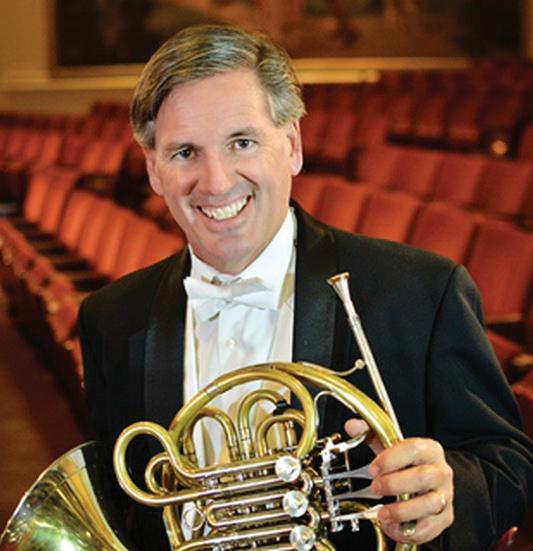
Some of the highlights of Mr. Hall’s career include: studying and listening to Dave Krehbiel at the San Francisco Symphony while earning a Master’s degree at the SF Conservatory; being the Fellowship Horn player for Leonard Bernstein at the LA Philharmonic Institute; building French horns as apprentice for George McCracken; learning band instrument repair with Gene Beckwith at the Red Wing School; enjoying the sunsets while playing in the Tucson Symphony and attending the University of Arizona; being a cabin counselor and water safety instructor at Interlochen; singing tenor with his dad in the National Presbyterian Choir; having his daughter Valerie sing and dance in the San Diego Opera's production of Hansel and Gretel (Doug was performing in the pit...)
During the rebuilding of the SDSO in the early “aughts” (after the hiring of former music director Jahja Ling), Doug ran more than 60 national auditions during his former service as assistant orchestra personnel manager. He also appeared in key marketing and fundraising materials during that period of recovery.
In retirement, you will likely find Doug on the links of the Torrey Pines or Coronado golf courses, walking the beach with his wife Laura, playing racquetball, or, because he really can’t help himself, building specialty French Horns. We thank Doug for his excellent musicianship through the years, as well as the warm relationships he cultivated over the decades with Symphony donors, staff and his fellow musicians, and wish him a happy and healthy retirement!

Cherry Yeung is a violinist born and raised in Hong Kong. Winning her first job at one of the major orchestras in the United States at the age of 21, Ms. Yeung is now the Associate Principal Second Violin of the San Diego Symphony Orchestra. When not playing music you can catch Cherry playing video games or trying out new recipes at home. Read on to learn more!
1. Tell us about your musical journey. How did you decide to become a professional classical musician? How did you come to the San Diego Symphony?
I started the violin totally by accident at nine years old. My brother wanted to learn cello growing up and so my mom tried signing us both up for cello lessons. Unfortunately, all the cello classes were filled, so they recommended we try violin instead. That’s how I started on violin! And fun fact, my brother actually quit violin after a month because he got tired of standing up while playing. I ended up continuing and eventually decided that I wanted to be a professional classical musician.
In my last year in school, I started the audition process. The San Diego Symphony audition was one of my first auditions I had taken that year and luckily it worked out! I ended up getting the Associate Principal Second Violin job. I remember my parents were so happy about it, because they love San Diego and my brother used to live in San Diego, so my family thinks it was truly fate that brought me here to San Diego.
2. What is your favorite San Diego Symphony memory so far?
My favorite San Diego Symphony memory would be playing my very first concert here, the program Verdi’s Requiem I remember almost tearing up when the audience gave us a standing ovation and feeling like all the hard work paid off. I have played with many professional orchestras before, but nothing can top your very first concert as a full-time professional musician. It was a momentous occasion that marked the start of my career.
3. What concerts are you looking forward to playing this summer?
I am most looking forward to the Jason Mraz concert. I grew up listening to his songs and I just love them—listening to them as well as singing them for karaoke. His songs are just so classic and it’s cool that he lives in San Diego!
4. Jacobs Music Center reopens on September 28th. What are you looking most forward to being back in our indoor music hall?
I am very excited for the reopening of Jacobs Music Center. Since I joined the symphony in 2022, I have never seen the hall before, and I’ve spent most of my time here playing at The Rady Shell. I am very excited to be going back to our indoor music hall because the acoustics there are just so wonderful. We also have lots of great programs next season and we get to play with some really good soloists, so I am just very excited.
5. When not performing with the San Diego Symphony, how do you like to spend your free time?
I am such a homebody. I love staying in and just watching different kinds of movies. I also love playing video games too. Some of my favorites are Mario Kart, Mario Party and PUBG where I reached ace master tier. I also love cooking and trying out different recipes at home.


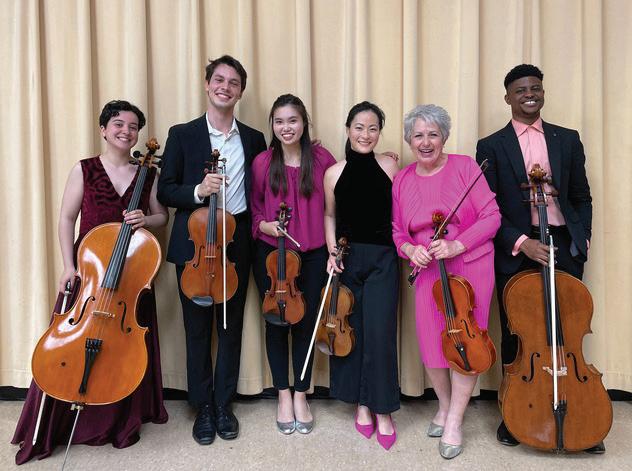
The San Diego Symphony acknowledges the following donors who have made a gift of $10,000 or more toward the BUILDING A SOUND TOMORROW campaign, which supports the renovation of Jacobs Music Center and the San Diego Symphony Foundation’s endowment fund. With profound gratitude, we celebrate these generous supporters who have made a commitment to the future of music in our community. To make a gift please call (619)237-1969 or email campaign@sandiegosymphony.org.
The following listing reflects pledges or gifts entered as of August 8, 2024
◊ denotes Deceased
$3,000,000 AND ABOVE
Joan ◊ and Irwin Jacobs
Pamela Hamilton Lester
In Memory of James A Lester
The Miller Fund
Price Philanthropies Foundation
$1,000,000 to $2,999,999
Willis J. Larkin
Lou and Penny Rosso and the Rosso Family
Robert Rubenstein and Marie Raftery
Karen Foster Silberman & Jeff Silberman
Elaine Galinson and Herbert Solomon Through the Glickman Fund of the S.D. Jewish Community Foundation
Haeyoung Kong Tang
Katherine “Kaylan” Thornhill Artistic Initiatives Fund
Timmstrom Family
$250,000 - $499,999
Anonymous
Michele and Jules Arthur
Julia R. Brown
Arlene Inch
Debby and Hal Jacobs
Karen and Warren Kessler
Jerry and Terri Kohl
Sandy and Arthur ◊ Levinson
Imozelle and Jim McVeigh
Robert Glenn Rapp Foundation
Colette Carson Royston and Ivor Royston
Donald and Gayle ◊ Slate
James E. and Kathryn A. Whistler
$100,000 - $249,999
Anonymous
Eloise and Warren Batts
David Bialis
Drs. Edward A. and Martha G. Dennis
The Fuson Family
In honor of Ted and Audrey Geisel
Tom and Carolina Gildred
Annie and Jeffrey Jacobs
The Littman Jonkman Community Engagement and Education Fund
Susan and Peter Mallory
In honor of Martha Gilmer
Robert, Monica and Celeste Oder
Chris and Kris Seeger
Dave and Phyllis Snyder
Sue and Bill ◊ Weber
Jo and Howard ◊ Weiner
$500,000 - $999,999
Anonymous
The James Silberrad
Brown Foundation
Dr. Paul and Geneviève Jacobs
Dr. Seuss Foundation
Mitchell R. Woodbury
$25,000 - $49,999
Una Davis Family
Janet and Wil Gorrie
The Hong-Patapoutian Family
In honor of Willard Howard Kline
In memory of Alex and Judy McDonald
Linda and Shearn* Platt
Ingrid M. Van Moppes
Waldron Family Trust
$10,000 - $24,999
Susan and Peter Crotty
Peter Czipott and Marisa SorBello
Monica Fimbres
In memory of Lillian Hauser
The Rev. Michael Kaehr
Joan Lewan Trust
David Marchesani
Jack McGrory
Deborah Pate and John Forrest
Joan Salb Trust
Linda Thomas
In Honor of John Zygowicz
$50,000 - $99,999
Carol Rolf and Steven Adler
Lisa and Ben Arnold
Richard A. Samuelson


The Beethoven Society is designed to raise consistent, critical funding for artistic, educational and community programs. Members pledge multi-year support and commit to annual gifts of $50,000 and higher, designated for projects ranging from classical and jazz concerts to education and military programs.
The Symphony and its Board of Directors are pleased to thank the following for their leadership and to acknowledge them as Members of The Beethoven Society.









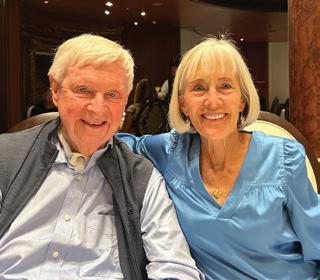

















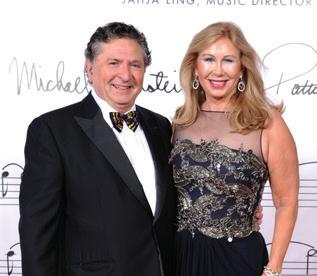


Friday, December 13 | 7: 30PM
Saturday, December 14 | 2PM & 7: 30PM
Sunday, Decmeber 15 | 2PM & 7: 30PM
Jacobs Music Center
Christopher Dragon, conductor
Jonathan Gilmer, director
San Diego Master Chorale
San Diego Children’s Choir
San Diego Symphony Orchestra
Additional artists to be announced

Audiences will experience the return of Noel Noel at Jacobs Music Center, a program full of Christmas classics. The concert will be led once again by the artistic tour-de-force team consisting of celebrated guest conductor Christopher Dragon and Director Jonathan Gilmer, and it features the return of the San Diego Symphony Orchestra, San Diego Master Chorale and the San Diego Children’s Choir.
Sponsored by PNC Bank

Saturday, November 30 | 7: 30PM Jacobs Music Center
Leslie Odom, Jr. brings a night of holiday hits to Jacobs Music Center—including selections from his release The Christmas Album, which BroadwayWorld said “infuses love, joy, and merriment into the holiday season.”
Please note: the San Diego Symphony Orchestra does not appear on this program.

Thursday, December 19 | 7: 30PM Jacobs Music Center
Voctave’s holiday spectacular It Feels Like Christmas includes a stocking full of holiday favorites from their chart-topping album and is sure to be a magical evening of music for the whole family. Jazz Weekly raves “Voctave bring a cappella music to a new dimension.”
Please note: the San Diego Symphony Orchestra does not appear on this program.

Saturday, December 21 | 7: 30PM Sunday, December 22 | 2PM & 7: 30PM Jacobs Music Center
Bruce Kiesling, conductor
San Diego Symphony Orchestra
Buddy was accidentally transported to the North Pole as a toddler and raised among Santa’s elves. This holiday season, Buddy travels to New York—with a live symphony orchestra! Experience John Debney’s wonderful score as the full film plays on the big screen. Brought to you by CineConcerts.

SATURDAY, OCTOBER 12 7:30PM
SUNDAY, OCTOBER 13 2PM
Jacobs Music Center
2024 JACOBS MASTERWORKS
Rafael Payare, conductor Sergey Khachatryan, violin San Diego Symphony Orchestra
BRAHMS
Violin Concerto in D Major, Op. 7
Allegro non troppo
Adagio Allegro giocoso, ma non troppo vivace
Sergey Khachatryan, violin
-INTERMISSION-
SCHOENBERG
Pelléas und Mélisande, Op. 5
Total Program Duration: 1 Hour 42 Minutes (includes one, 20 minute intermission).

Scan this QR code with your smartphone or text SDS to 55741 to access the interactive version of the program.
Message frequency will vary. Message and Data rates may apply. Text STOP to cancel and HELP for help. SMS Terms of Service and Privacy Policy can be found at https://theshow.ihub.app/contact
RAFAEL PAYARE
See bio on page P5.
This 24/25 season Sergey’s international presence is sustained by performances with RAI National Symphony Orchestra (Cristian Măcelaru), Lyon National Orchestra (Nikolaj Znaider), Accademia Nazionale di Santa Cecilia (Myung-Whun Chung), Montréal Symphony Orchestra (Rafael Payare), Frankfurter Museumsorchester (Michael Sanderling), Orquesta de Valencia (Alexander Liebrich), Toronto Symphony Orchestra (Tarmo Peltokoski), Gävle Symfoniorkester (Case Scaglione) and a Spanish tour with Bilbao Symphony Orchestra (Joana Carneiro).
Highlights of the previous seasons include Sergey’s residency with Orquesta de Valencia, comprising several concerts conducted by Alexander Liebreich including a chamber project, Sergey’s residency at the BOZAR in Brussels which comprised of a pair of recitals and a concert with Orchestre National de Belgique and Hugo Wolff. Re-invitations included the Finnish Radio Symphony Orchestra, Orchestra dell’Accademia di Santa Cecilia, Rotterdam and Royal Flemish Philharmonic Orchestras, and the Cleveland Orchestra. Sergey also embarked on a tour of the US and Europe with Alisa Weilerstein and Inon Barnatan with a programme entitled Transfigured Nights featuring the music of Beethoven, Schoenberg and Shostakovich. Other recent projects included a tour of Japan with the Nippon Foundation and in 2014/15 Sergey performed Beethoven’s Violin Concerto at the Lucerne Festival with the Vienna Philharmonic and Gustavo Dudamel as the recipient of the Credit Suisse Young Artist Award.
Born in Yerevan, Armenia, Sergey Khachatryan won First Prize at the VIII International Jean Sibelius Competition in Helsinki in 2000, becoming the youngest-ever winner in the competition’s history. In 2005 he claimed First Prize at the Queen Elisabeth Competition in Brussels. n

Born May 7, 1833, Hamburg
Died April 3, 1897, Vienna
APPROXIMATE PERFORMANCE TIME
38 MINUTES
Brahms spent the summer of 1878 in Pörtschach on the Wörthersee. He loved this resort town on the lake surrounded by snow-capped mountains, and to a friend he noted how much he felt like writing music there: “So many melodies fly about that one must be careful not to tread on them.” Brahms set out that summer to write something for his friend and colleague of twenty-five years, the great violinist Joseph Joachim. Brahms did not play the violin, and he consulted frequently with Joachim during the composition of this concerto, asking for advice and criticism (some of which he took, some he did not). In its original form, this concerto was in four movements, but Brahms threw out the two middle movements, replacing them with what he called – with characteristic self-deprecation – “a feeble Adagio.” Joachim was soloist and Brahms the conductor at the premiere in Leipzig on January 1, 1879.
Brahms’ Violin Concerto is extraordinarily difficult for the soloist, and in a famous jibe it has been called “a concerto against the violin rather than for it.” But this music is not impossible, and in fact Brahms’ Violin Concerto is quite playable and even quite violinistic. It requires a tremendous violinist, one with the ability to make huge leaps and land with dead-center accuracy, to project the violin’s sound over a large orchestra, and to have hands big enough to play the tenths that Brahms frequently calls for. Yet this is not a showy or a flashy piece. Violin and orchestra are beautifully integrated, with the melodic line flowing seamlessly between them, and the soloist’s skills are always at the service of the music, rather than the reverse.
Brahms stays close to classical tradition in the first movement, where a long orchestral exposition introduces the themes before the entrance of the violinist. The very beginning, with its arching and falling main subject, is distinctive for the way Brahms manages to disguise the meter: it is in 3/4, yet the stresses of the opening phrases obscure the downbeats. Solo oboe introduces the second theme, and the full string section stamps out the third. (This last bears a close relation to the opening of Bach’s Chaconne for unaccompanied violin, a work Brahms very much admired). Only when these themes have been fully presented does the solo violin enter with its dazzling twooctave run up the scale, followed by a series of blistering string-crossings. This is a big, dramatic movement, and it can make a huge sound, but the score itself is littered with Brahms’ performance instructions, and these make clear what he believed the true character of this music to be: dolce, espressivo, tranquillo, lusingando (a term that does not translate easily from the Italian, but means
generally coaxing or charming). Much of the writing for violin is graceful and lyric, and in particular Brahms’ transformation of the second subject into a slow waltz is a moment of pure magic.
Perhaps as a nod to Joachim, Brahms did not write out a cadenza for the first movement. Joachim produced a splendid one, and others have been drawn to write their own. One of the other magic moments in this movement comes with the return of the orchestra at the end of the cadenza: over quiet accompaniment, the violinist lays out once again the movement’s opening theme and then takes it very high on long sustained notes as the orchestra sings far below. Gradually the music descends from these Olympian heights, gathers momentum and strength, and hurtles to the resounding D-Major chord that closes the movement.
The Adagio, in F Major, is anything but “feeble.” The entire opening statement is given to the wind choir, and it is the solo oboe rather than the solo violin that announces the main idea of the movement – when the violinist enters, it is with music that is already a variation of the oboe’s noble song. The center section, which moves to F-sharp minor, grows much more impassioned, with the violin burning its way high above the orchestra before the return of the poised opening material.
The last movement is the expected rondo, which Brahms marks Allegro giocoso (“fast and happy”), but he also specifies ma non troppo vivace: “not too fast.” Many have remarked on the Hungarian flavor of this movement, and some have seen this as another nod toward Joachim, who was Hungarian. In fact, Brahms loved Hungarian music (which for him meant – more exactly – gypsy music), and he hardly needed an excuse to compose in that style. This is a difficult movement for the soloist, full of extended passages in octaves and great leaps across the range of the violin, but there are some wonderfully lyric interludes along the way. A great cascade of runs from the violinist introduces the coda, where Brahms subtly recasts the 2/4 rondo tune so that it seems to be in 6/8. This gathers strength, and all appears set for the expected closing fireworks, but in the last measures Brahms springs one final surprise, winding the music down so that it seems almost to have lost its way before three great chords ring out to proclaim the true close. n
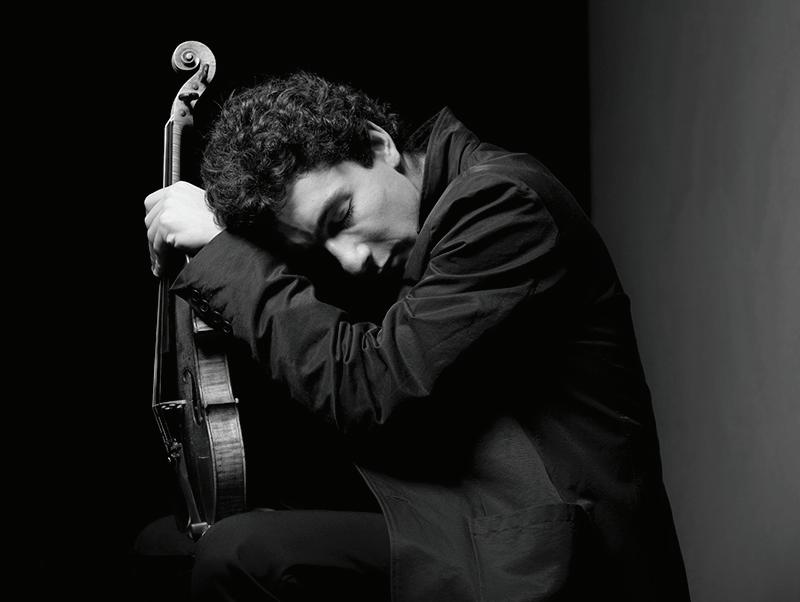
Born September 13, 1874, Vienna
Died July 13, 1951, Los Angeles
APPROXIMATE PERFORMANCE TIME
41 MINUTES
Belgian playwright Maurice Maeterlinck’s Pelléas et Mélisande was first produced in Paris on May 17, 1893, and it quickly took the world by storm. A grim medieval romance with Arthurian overtones, Pelléas et Mélisande tells the dream-like story of Melisande, a young woman who is found, wandering and disoriented, in the forest by Golaud, a prince out on a royal hunt. He takes her back to his castle and eventually marries her, but Golaud’s brother Pelleas is himself strongly attracted to Melisande, and he and Melisande fall in love. Golaud becomes suspicious, and although Pelleas and Melisande have resolved never to see each other again, Golaud kills Pelleas, and Melisande dies after giving birth to a child. It is difficult to convey how powerfully this tale – full of doomed love and an evocation of a misty and more romantic past – influenced the younger generation at the turn of the century, particularly the younger generation of composers. Claude Debussy wrote an opera based on it, Gabriel Fauré and Jean Sibelius both wrote incidental music for productions of the play, and Mel Bonis wrote a piano piece titled Mélisande in her Femmes de legende series.
One other composer – an unlikely one, at first glance –was strongly taken by this tale of doomed love. Arnold Schoenberg was so moved by Maeterlinck’s play that he thought of writing an opera based on it. (He did not know of Debussy’s opera until after its premiere in 1902). But he abandoned plans for an opera and instead composed a tone poem he titled Pelléas und Mélisande
Schoenberg was quite aware of the recent tone poems of his friend Richard Strauss, but he did not set out to write that kind of work. Strauss once bragged that he could set a glass of beer to music, and he set out to “tell” stories in his tone poems: he would create specific themes for different characters (Don Quixote, Till Eulenspiegel, and so on) and then portray their adventures in detailed music. Schoenberg saw the tone poem somewhat differently. Like Strauss, he composed themes or motifs that he identified with specific characters or actions, but instead of depicting their actions to tell a story, he used those musical ideas to compose what is in effect a fourmovement symphony. His story-telling is much more abstract than what Strauss would have written on the same topic, but it is a compelling on its own terms as his “medieval” themes evolve in classical forms, in the process mirroring Maeterlinck’s dark tale.
Schoenberg composed Pelléas und Mélisande between July 1902 and February 1903, shortly after composing Verklaerte Nacht. He had at this point not abandoned tonality (both those scores have key signatures), but his music was growing increasingly chromatic in these years.
Schoenberg’s scoring emphasizes the lower and middle registers of the orchestra, and there are particularly prominent roles here for the English horn and the violas. Pelléas und Mélisande is a big work: its four sections, which are played without pause, stretch out to about 45 minutes.
Here follows a brief guide to those four sections, to Schoenberg’s motifs and how they represent characters, and to the “events” of each of the sections. The opening section, in sonata form, corresponds to the first movement of a symphony, and in the first few moments we hear – in the bass clarinet – the four-note “fate” motif that will reappear in many forms throughout. This opening section, set in a deep forest, gradually introduces the themes associated with each character. “Melisande in her helplessness,” as Schoenberg described her, is portrayed by a plaintive, falling oboe melody. Golaud is introduced by a noble theme from the horn section (Schoenberg seems unusually sympathetic to Golaud in this recounting of the tale), and finally Pelleas – who as Schoenberg said, has a “youthful and knightly character” – is portrayed by an angular theme for solo trumpet. Along the way we hear the theme of Melisande’s awakening love; it begins in the solo clarinet and is taken over by a solo violin that soars ever higher.
The second section corresponds to the scherzo of a symphony. At a faster tempo, it is built on themes that portray Melisande at the fountain, where she playfully tosses her wedding ring in the air before having it fall into the fountain; the growing attraction between Pelleas and Melisande; the scene in the tower where Melisande combs down her long hair (Pelleas caresses that hair, and at that moment they are discovered by Golaud); and the scene in which Golaud – now growing suspicious – leads Pelleas through the catacombs beneath the castle.
The third section is a slow movement that brings the drama to its first climax: this music “depicts” the night scene at the fountain in the park, the warm love music between Pelleas and Melisande, and Golaud’s taking up his sword and murdering Pelleas.
The concluding section brings the death of Melisande, who dies proclaiming her innocence. This “finale” recapitulates themes introduced in the opening section, including numerous repetitions of the fate motif. The movement rises to a climax on a noble restatement of Golaud’s theme, and Schoenberg’s vision of Maeterlinck’s tale concludes loudly, dramatically –and very darkly.
Years later, Schoenberg wrote of the premiere: “The first performance, 1905 in Vienna, under my own direction, provoked great riots among the audience and even the critics. Reviews were unusually violent, and one of the critics suggested putting me in an asylum and keeping music paper out of my reach. Only six years later, under Oscar Fried’s direction, it became a great success, and since that time has not caused the anger of the audience.” n -Program notes by Eric Bromberger
The Musicians, members of the Board of Directors and the Administrative Staff wish to gratefully acknowledge the growing list of friends who give so generously to support the San Diego Symphony. To make a gift, please call (619) 615-3901. The following listing reflects pledges entered as of August 8, 2024.
STRADIVARIUS CIRCLE:
$100,000 AND ABOVE
Raffaella and John◊ Belanich
City of San Diego Commission for Arts and Culture
Joan◊ and Irwin Jacobs
Dorothea Laub
The Miller Fund
The Conrad Prebys Foundation
MAESTRO CIRCLE:
$50,000-$99,999
Anonymous
Michele and Jules Arthur
Terry L. Atkinson
Dianne Bashor
Alan Benaroya
John and Janice Cone
Kevin and Jan Curtis
Una Davis and Jack McGrory
Mr. and Mrs.* Brian K. Devine
Daniel J. and Phyllis Epstein
Pam and Hal Fuson
Elaine Galinson and Herbert Solomon
Carol and Richard Hertzberg
Arlene Inch
Brooke and Dan◊ Koehler
Karen and Warren Kessler
The Kong Tang Family
Carol Ann and George Lattimer
Monica and Robert Oder
Linda and Shearn◊ Platt
Price Philanthropies
Qualcomm Charitable Foundation
Marie Raftery and Dr. Rubenstein
Jacqueline and Jean-Luc
Robert
Elena Romanowsky
Penny and Louis Rosso

Colette Carson Royston and Ivor Royston
Jean and Gary Shekhter
Karen and Kit Sickels
Karen Foster Silberman and Jeff Silberman, Silberman Family Fund
Les J. Silver and Andrea Rothschild-Silver
Gayle◊ and Donald Slate
Dave and Phyllis Snyder
Gloria and Rodney Stone
Jayne and Bill Turpin
Vail Memorial Fund, Meredith Brown, Trustee
Leslie and Joe Waters
Sue and Bill* Weber
Jennie Werner

Kathryn and James Whistler
Cole and Judy Willoughby
Mitchell Woodbury
Sarah and Marc Zeitlin
GUEST ARTIST CIRCLE:
$25,000-$49,999
Anonymous (2)
Eloise and Warren Batts
David Bialis
The Bjorg Family
Annette and Daniel Bradbury
Nikki A. and Ben G. Clay
Karen and Donald Cohn
Stephanie and Richard Coutts
Drs. Edward A. and Martha G. Dennis
Karin and Gary Eastham
Shirley Estes
Anne L. Evans
Lisette and Mick Farrell, Farrell Family Foundation
Kelly Greenleaf and Michael Magerman
Lisa and Gary Levine
Sandra and Arthur◊ Levinson
Eileen Mason
Anne and Andy McCammon
Deborah Pate and John
Forrest
Padres Foundation
Maryanne and Irwin Pfister
Allison and Robert Price
Dr. Carol Randolph and Robert Caplan,
Seltzer Caplan
McMahon Vitek
Sally and Steve Rogers
Jeanette Stevens
Sandra Timmons and Richard Sandstrom
Sheryl and Harvey White
Young Presidents’
Organization San Diego Gold
The Zygowicz Family (John, Judy, and Michelle)
CONCERTMASTER CIRCLE:
$15,000-$24,999
Anonymous
Diane and Norman
Blumenthal
Dr. Anthony Boganey
Gisele Bonitz
The Boros Family
Gordon Brodfuehrer
Julia Richardson Brown Foundation
California Arts Council
Sally Cuff
Ann Davies
Kathleen Seely Davis
Ana de Vedia
The Donald C. and Elizabeth M. Dickinson Foundation
Hon. James Emerson
Monica Fimbres
Dr. Joyce Gattas and Jay Jeffcoat
Janet and Wil Gorrie
Judith Harris◊ and Dr. Robert Singer
Laurie Sefton Henson
Marilyn James and
Richard Phetteplace
The Rev. Michael Kaehr
Jo Ann Kilty
Helen and Sig Kupka
Linda and Tom Lang
Carol Lazier and Dr. James
Merritt
Jill Gormley and Laurie
Lipman
Dr. Marshall J. Littman
Anne and Andy McCammon
Sue and Lynn Miller
One Paseo
Rena Minisi and Rich Paul
Lori Moore-Cushman Foundation
James and Josie Myers
The Kenneth T. and Eileen L. Norris
Foundation
Val and Ron Ontell
Jane and Jon Pollock
Pamela and Stephen Quinn
Dr. Andrew Ries and Dr. Vivian Reznik
Cathy and Lawrence◊
Robinson
Ellen Browning Scripps Foundation
Chris and Kris Seeger
Stephen M. Silverman
Hon. Stephanie Sontag and Hon. David Oberholtzer
Sylvia Steding and Roger◊
Thieme

Elizabeth and Joseph◊ Taft
Gayle and Philip Tauber

R.V. Thomas Family Fund
Julie and Stephen Tierney
Isabelle and Mel◊ Wasserman
Lisa and Michael Witz
VIRTUOSO CIRCLE: $10,000-$14,999
Anonymous
Carol Rolf and Steven Adler
Guity Balow
P. Kay Coleman and Janice E. Montle
Anna Curren
Nina and Robert Doede
Karin and Alfred Esser
Norman Forrester and Bill Griffin
Scott and Tracy Frudden
Lynn and Charles Gaylord
Martha and William Gilmer
Hanna and Mark Gleiberman
Vicki Garcia-Golden and Tim Jeffries
Georgia Griffiths and Colleen Kendall
Kay and Bill Gurtin
Jason and Somi Han
Beverley Haynes

Hervey Family Fund
Richard A. Heyman and Anne E. Daigle Family Foundation
The Hong-Patapoutian Family
Nancy and Stephen Howard
Richard and Elisa Jaime
Jeffrey and Claudia Lee
Robert Leone
Bill and Michelle Lerach
Terry and Tom Lewis
Susan and Peter Mallory
Larry McDonald and Clare White-McDonald
Oliver McGonigle
Elizabeth and Edward McIntyre
MDM Foundation
Helga S. Moore
Rebecca Moores
Morrison & Foerster
Trupti and Pratik Multani
Donald and Clara Murphy
Dave and Jean Perry
Claudia Prescott
Sandy and Greg Rechtsteiner
ResMed Foundation
Harold and Evelyn Schauer
Jayne and Brigg Sherman
Katherine “Kaylan” Thornhill
University of San Diego
Tim and Jean Valentine

K. Nikki Waters
Edward and Anna Yeung
ORCHESTRA CIRCLE: $5,000-$9,999
Anonymous (2)
Sherry and Kevin Ahern
Cheryl and Rand Alexander
Bonnie and Krishna Arora
Kevin and Michelle Aufmann
Edgar and Julie Berner
Shara Williams and Benjamin Brand
Sophie Bryan and Matthew Lueders
Ken Bullock and Donna Bullock
Wendy Burk and Harold Frysh
Joseph Caso
Marilyn Colby
The den Uijl Family
Karen Dow
Susan Dubé
Berit and Tom Durler
Maria Beatriz Fimbres
Susanna and Michael Flaster
Gertrude B. Fletcher
Karen Forbes
Calvin Frantz
Ira Gaines and Cheryl Hintzen-Gaines
Arthur J. Gallagher Insurance
Carrie and James Greenstein
David and Claire Guggenheim
Beau Haugh
Janet and Clive Holborow
Maryka and George◊ Hoover
Erika Horn
James B. Idell and Deborah C. Streett-Idell
Marge Katleman and Richard Perlman
Carol and Mike Kearney
Angela and Matthew Kilman
Krumholz Family Trust
Steve Lyman and Diane McKernan
Mark C. Mead
Menard Family Foundation
Judith Morgan
Adrian and Lorna* Nemcek
Patricia and Kent Newmark
David and Judith Nielsen
Alex and Jenny Ning
Mary Ann and David Petree
Elizabeth Pille
Peggy and Peter Preuss
Sheli and Burton X. Rosenberg
Jennifer and Eugene Rumsey Jr., M.D.
Sage Foundation
Robert and Barbara Scott
Ruey & Marivi Shivers
Sandra Smelik and Larry Manzer
Jennifer Stainrook
Larry and Pamela Stambaugh
Richard and Susan Ulevitch
Aysegul Underhill
Ronald and Diane Walker
Shirli Weiss
Jeffrey P. Winter and Barbara Cox-Winter
Elizabeth Wohlford McCloud and Clay Mac Cleod
Joan Zecher
Leo and Emma Zuckerman
SYMPHONY CIRCLE:
$2,500-$4,999
B.J. Adelson
Dede and Michael Alpert
Ellie and David Alpert
Lauren Lee Beaudry
Dr. Thomas Beers
Mr. Mark Bramson and Ms. Ellen Bramson
Loyce Bruce
John Cochran◊ and Sue Lasbury
Household
Marie Cunning
Mayra Curiel and Carlos Larios
Andrea da Rosa
Steven Davis
Caroline S. DeMar
Doris and Peter Ellsworth
Maria Carrera and Corey
Fayman
Luis Fimbres Astiazaran and Hilda Villasenor De Fimbres
Maria T. Fimbres Sanchez
Carmelita Fimbres
Ma Del Socorro Mendoza Fimbres
Richard Forsyth and Katherine Leonard
Ms. Linda Fortier
Linda and Michael Gallagher
Sharon and Garry Hays
Mert and Joanne Hill
Mr. Clifford Hollander and Mrs. Sharon Flynn Hollander
Sonya and Sergio◊ Jinich
Leon and Sofia Kassel
Thian Kheoh
Mayra Curiel and Carlos Larios
Ruth Wikberg-Leonardi and Ron Leonardi
Brian and Nancy Littlefield
Sylvia and Jaime◊ Liwerant
Robin & Charles◊ Luby
Glen P. Middleton
Takenori Muraoka
Aradhna and Grant Oliphant
Pratt Memorial Fund
Jeff and Clare Quinn
Christa and Gerald Reynolds
Sheena Sahni
Betty Scalice Foundation
Bonnie and Josef Sedivec
Linda J. & Jeffrey M. Shohet
Timothy Snodgrass and Elaine King
Steve and Carmen Steinke
DeAnne Steele and Carlo Barbara
Michiele Stivers
Jacqueline Thousand and Richard Villa
Col. and Mrs. Joseph C. Timmons
William Townsend
Norton S. and Barbara Walbridge Fund
Ronald and Diane Walker
Thomas P. Ward and Rosemary T. Ward
Stephanie and Stephen Williams
Carmen Young
Debi and Robert Young
Claudia and Paul Zimmer
Dr. and Mrs. Philip Ziring
CONCERTO CIRCLE:
$1,000-$2,499
Anonymous (3)
Dede and Michael Alpert
Hector and Jennifer Anguiano
Lyndsey and Allan W. Arendsee
Patricia and Brian Armstrong
Rusti Bartell
Rena and Behram Baxter
David and Jasna Belanich
Sondra Berk
Mary Ann Beyster
Virginia and Robert Black
Ralph Britton
Joseph H. Brooks and Douglas Walker
Joyce Burns
Vickie Camper
Barbara and Salvatore Capizzi
Stan Clayton
Rew P. Carne
Caroline Chen and George Boomer

Colwell Family Fund
Bob and Kathy Cueva
Georgia and Emery Cummins
Dr. Peter Czipott and Marisa SorBello
Trevor and Patricia Daniel
Anne and Charles Dick
Susan Diekman
Marguerite Jackson Dill and Carol Archibald
Sandra Dodge
John E. Don Carlos
Gail Donahue
Julie and Mitchell Dubick
Margaret Eastridge
Max Fenstermacher
Walt Charles Fidler
Yolanda Fimbres Hernandez
Louise Firme
The Herr Family
Eduardo Fimbres
Jose Fimbres
Lulu Fimbres
Marcis Fimbres Porras
Rosella Fimbres
Silvia Fimbres
Douglas Flaker
Stan Fleming, Forward
Ventures
Kenneth Fitzgerald
Stan Fleming, Forward Ventures
Jean Fort
The Samuel I. and John Henry Fox Foundation
Leonard and Marcia◊ Fram
Marilyn Friesen and John Greenbush
Judith Fullerton
Richard and Sharon Gabriel
Dr. Nancy Gold and Colin Seid
Linda R. Gooden
Jon and Carol Gebhart

Kenneth F. Gibsen Memorial Fund
Brenda and Michael Goldbaum
Laurie M. Gore
Sally and Dave Hackel
Fred Hafer and Noel Haskins-Hafer Household
Stephanie and John Hanson
Michelle Hebert
The Herr Family
Barbara and Paul Hirshman
Peggy and John◊ Holl
Lulu Hsu
Kenneth and Patricia Janda
Jay William Jeffcoat
Gina Kakos
Marge Katleman and Richard Perlman
Maurice Kawashima
Tandy and Gary Kippur –JCF of Southern AZ
Betty and Leonard Kornreich
Anona Kuehne
Rhea and Armin Kuhlman
Wilfred Kearse and Lynne Champagne
Robert and Laura Kyle
George & Mei Lai
Gautam and Anjali Lalani
Sharon Lapid
Eliza Lee
Jeffrey Lee
Greg Lemke
Stephen Lending
Gayle M. Lennard
Kiyoe MacDonald
Daniel and Chris Mahai
Amy and John Malone
Eugene Malone
Arnulfo Manriquez
Madonna Christine Maxwell
Susan and Douglas McLeod
Richard Michaels
David McCall and Bill Cross
Mr. Paul J. McMahon
Dr. Sandra E. Miner
Martha and Chuck Moffett
Bibhu P. Mohanty
Patricia Moises
Dr. Thomas Moore
David Morris
Drs. Elaine and Douglas
Muchmoore
Tom and Anne Nagel
Patricia R. Nelson
Patricia and Kent Newmark
Dr. Jon Nowak
Frank O’Dea
Ricki Pedersen
Sandra and David Polster
Anne Porter
Jim Price and Joan Sieber
Arlene Quaccia and Robin Hughes
Matthew and Sue Quinn
Robert Glenn Rapp Foundation
Janet and Bill Raschke
Keith Record
Dr. Marilyn Friesen and Dr. Michael Rensink
Darci Roger-Tracy
The Ryde Family
Memorial Foundation
Gloria and Dean Saiki
Susan and Edward Sanderson
Household
Judith and Robert Sharp
Lari Sheehan
Professor Susan Shirk
Kyle Short
Anne and Ronald Simon
Drs. Eleanor J. Smith and John D. Malone
Suzy Soo
Valerie Stallings
John E. Sturla II
Kathleen Sullivan
Harry V. Summer
Suzanne and William Sutton
Melissa Swanson
William Tong
Fred and Erika Torri
Jennifer Toth
Janet Anderson and Victor Van Lint
Janis Vanderford
Kathleen Victorino
Carol and Thomas Warschauer
Dr. Jeffrey and Barbara Wasserstrom
Janet and Joel Weber
Margaret Weigand
Eileen Wingard
Martha Wingfield
Joseph and Mary Witztum
Karen and Rod Wood
Britt Zeller
Herb◊ and Margaret Zoehrer
SONATA CIRCLE:
$500-$999
June and Daniel Allen
Dr. Robin Allgren
Alex Alonzo
Elizabeth Andersen
Philip Anderson
Andrade Family Trust
Arleene Antin and Leonard Ozerkis
Shane Arlt
Maureen Arrigo
Pamela and James Balderrama
Elaine Baldwin and Carl Nelson
Dr. Joshua Bardin
Joe Baressi Jr.
Patricia and Bruce Becker
Barry and Emily Berkov
Elena Bernardi
Dr. Leonard and Beverly Bernstein
Jerry and Karen Blakely
Stephen and Priscilla Bothwell
Mary Catherine Bowell
Gloria and Sed Brown
Alyssa Brzenski
Jolie and Glenn Buberl
Ed Budzyna and Zack Zaccaria
Robert and Carolyn Caietti
William Carrick
Gloria and Maurice Caskey
Juliana Caso
Caroline Chen and George Boomer
Tanya and Sutton Chen
Geoff and Shem Clow
Dale Connelly
Patrick and Lisa Cooney
Joe Costa
John Cuthbertson and Elizabeth Hamilton Cuthbertson
Dr. Michael D’Angelo
Dr. Dalia Daujotyte
Julie and Don De Ment
Marilou Dense
Dr. Greg Dixon
Donna F. Dotson
Elizabeth and Richard Dreisbach
Pamela Dunlap
Jeffrey Edwards
Drs. Eric and Barbara Emont
Robyn Erlenbush
Jeane Erley
Arlene Esgate
Joel Ewan and Carol Spielman-Ewan
Anne Porter Finch
Linda Lyons Firestein
Darlene and Robert Fleischman
John Foltz
Nynke Fortuin
Michele Fournier
Michelle Fox
Laura Georgakakos
Diane Glow
Eric Gnand
Dr. William Goggin
Kathleen and John Golden
Ser Andre Gonzalez
James Gordon
Robert Griffin
Stephanie and H. Griswold
Dean Haas
James Hannan
Angela Hansen
Gerald Hansen and Marilyn Southcott
Christine Harmon
Lydia Harris
Sue Haverkamp
Brian Hays
Jill Herbold
Harold Hoch
Anne S. Holder-Erdman
Sandra Hoover
Gurdon Hornor
Warren Hu
Ralph Hull
Charlotte Langmaid and David Hunter
Intuit Foundation
Faith and Steve Jennings
Bjorn and Brigette Jensen
Dimitri and Elaine Jeon
Robert Jentner
Dimitri and Elaine Jeon
Deborah Jezior
Benjamin Johnson
Bruce A. Johnson
R. Douglas and Jeanette Johnson
Ronald Johnson
Thesa Lorna Jolly
Sabby Jonathan
Julia Katz
Wilfred Kearse and Lynne Champagne
Dwight A. Kellogg
John and Sue Kim
Cynthia King
Jeremy Kolins
Stephen Korniczky
Andrea and Stephen Kowalewsky
Martha and Jerry Krasne
Robert and Elena Kucinski
Mary Kyriopoulos
Philip Larsen
Laura Laslo
Elizabeth Leech
Lewis Leicher
Kathleen Lennard
Stacey LeVasseur Vasquez
Denee and Xiaoping Logan
David Louie
Claudia Lowenstein
Daniel Lysne
Scott MacDonald
Anne Macek
Kyong Macek
Micolyn Magee
Annie Cruz Magill
Patricia Mahtani
Deborah and Fred Mandabach
Sue Marberry
Ana Esther Martinez
Beverly and Harold Martyn
James R. Mathes
Kyle McEachern
Mac McKay
Susan and Douglas McLeod
Narriman McNair
Daniel McNaughton
James and Estelle Milch
Dr. Grant Miller
Ann Morrison
Jan and Mark Newmark
Barbara and Donald Dean Niemann
James and Jean O’Grady
Larry and Linda Okmin Household
Abraham Ordover
Brent Orlesky and Ronald T. Oliver
Abraham Ordover
Brent Orlesky and Ronald T. Oliver
Yolanda Ortiz Palacio
Dr. Robert Padovani
Marilyn Palermo
Julie Park
Julian Parra
Sally and Phillip Patton
Robert Plimpton II
Dean Popp
Joseph and Sara Reisman
Cindy and Daniel Reynolds
Patrick Ritto
Nancy Robertson
Steve and Cheryl Rockwood
Louis Rosen
Alice Rosenblatt
Ronnie and Stuart Rosenwasser
Rose Marie and Allan Royster
Norman and Barbara Rozansky
Mary Salas
Mary Margaret Saxton
Gretchen Louise Schafer
Joel Schaller
Mr. Daniel H. Schumann
David and Martha Schwartz
Thomas Schwartz
Dr. Bruce Shirer
Martha Shively
Stanley Siegel
Linda Small
Marilyn and Brian Smith
Darryl and Rita Solberg
Amelia Soudan
James and Phyllis Speer
Gregory Stanton
Regenia Stein and Roland
James
Mark Stenson
Judy S. Stern
John L. Stover
Derek Stults
Nancy and Michael Sturdivan
Kimberly Sullivan
Nelson Surovik
Kay and Cliff Sweet
Thomas Templeton and Mary Erlenborn
Paul and Mary Anne Trause
Steven Traut
Jean and Mark Trotter
Orlando S. Uribe
Allen Voigt
VOSA Student Symphony Ticket Fund
Loren Waldapfel
John Walsh
Rex and Kathy Warburton
Don and Sharon Watkins
Janet and Joel Weber
Irene, David◊ & Diana Weinrieb
Mike and Janet Westling
Joyce Williams
Stephen Wilson
Symphorosa Williams
Mary Michele Wilmer
Sherri Wittwer
Noel Wheeler
David A. Wood
Karen and Rod Wood
Victor T. Yamauchi
Peter and Terry Yang
Naima and Mike Yelda
Maria and Randy Zack
In memory of John Cochran
Sue Lasbury
In memory of Sandra Cohen
Anonymous
In memory of Peter Eros, Georgia Eros, Dale Klabunde
Eileen Wingard
In memory of Marcia Fram
Leonard Fram
In memory of Matthew Garbutt
Shirley Estes
In memory of James Jessop Hervey
Linda Hervey
In memory of Joan Jacobs
Alan Benaroya
Stuart and Barbara Brody
Dr. Peter Czipott and Marisa SorBello
Susan and Steven Davis
Roy Devries
Robert and Nina Doede
Stan Flemming, Forward Ventures Globalstar
Jewish Community Foundation
Douglas and Susan McLeod
Karen and Jeffrey Silberman Family Fund
Frank O’Dea
Linda and Shearn* Platt
Anne Porter
Claudia Prescott
Allison and Robert Price
Alicia Rockmore
Lea Schmidt-Rogers and Larry Rogers
Jack Strecker
Allen and Helene Ziman
In memory of Sergio Jinich
Sonya Jinich
In memory of Bob Kyle
Laura Kyle
In memory of Mariam Lapid
Sharon Lapid
In memory of Judy McDonald
Pam and Hal Fuson
Judith Morgan
Stephanie and Richard Coutts
In memory of Judy and Alex McDonald
Ross Cohen and Valerie Leman
In memory of Bob Nelson Who Loved the Music, the Bay and San Diego
Kevin Tilden
In memory of Lorna Nemcek, wife of Adrian Nemcek from their friends at Mason Investment Advisors
David Engler
In memory of Lloyd Pernela, Ethan Pernela’s father
Ann Morrison
Lois Richmond (of blessed memory)
Jewish Community Foundation
In memory of Bruce Sutherland

Jo-Anne Brownwood
In memory of Bill Weber
Colette Carson Royston and Ivor Royston
Joyce Burns
Elaine and Dave Darwin
John Bloedorn
Franci Free
Patricia and Kent Newmark
Bob Morris
Penny and Lou Rosso
Linda and Michael Galagher
In memory of Bill Weber and Judy McDonald
Kathleen Seely Davis
In memory of David and Ilene Weinreb
Diana Weinreb
HONORARIA GIFTS
In honor of Victoria Andujar
Vance and Gloria Baker
In honor of Jan and Kevin Curtis
Claudia Levin
In honor of Matt Garbutt
Eileen Wingard
In honor of Melanie Gillette
Vance and Gloria Baker
In Honor of Dr. Melvin Goldzband’s 94th Birthday
Claudia Levin
In Honor of James and Theresa Grant, and Maria Atkins
Thao Hughes
In honor of Dr. Nancy Hong
Susan Diekman
In honor of Dr. Irwin Jacobs’s 90th Birthday
Paul Jacobs
Rebecca Moores
In honor of Lang Lang, Martha Gilmer and the wonderful San Diego Symphony Orchestra for a fantastic musical experience at The Rady Shell
Dr. and Mrs. Philip Ziring
In honor of Cheri LaZarus
Joani Nelson
In honor of Harriett Mallory
Kris and Pam Mallory and Linda Dawson
In honor of Rabbi Matthew Marko
in care of Tifereth Israel Synagogue
Laurie M. Gore
In honor of Dr. Dianne Moores
Ralph Hull
In honor of Ray Nowak
Linda Thomas
In honor of Dave and Phyllis Snyder
Barbara and Robert Scott
In honor of Mr. Gene Summ’s 93rd birthday
Dr. and Mrs. Philip Ziring
In honor of the retirement of Marsha Zeven
Eileen Wingard
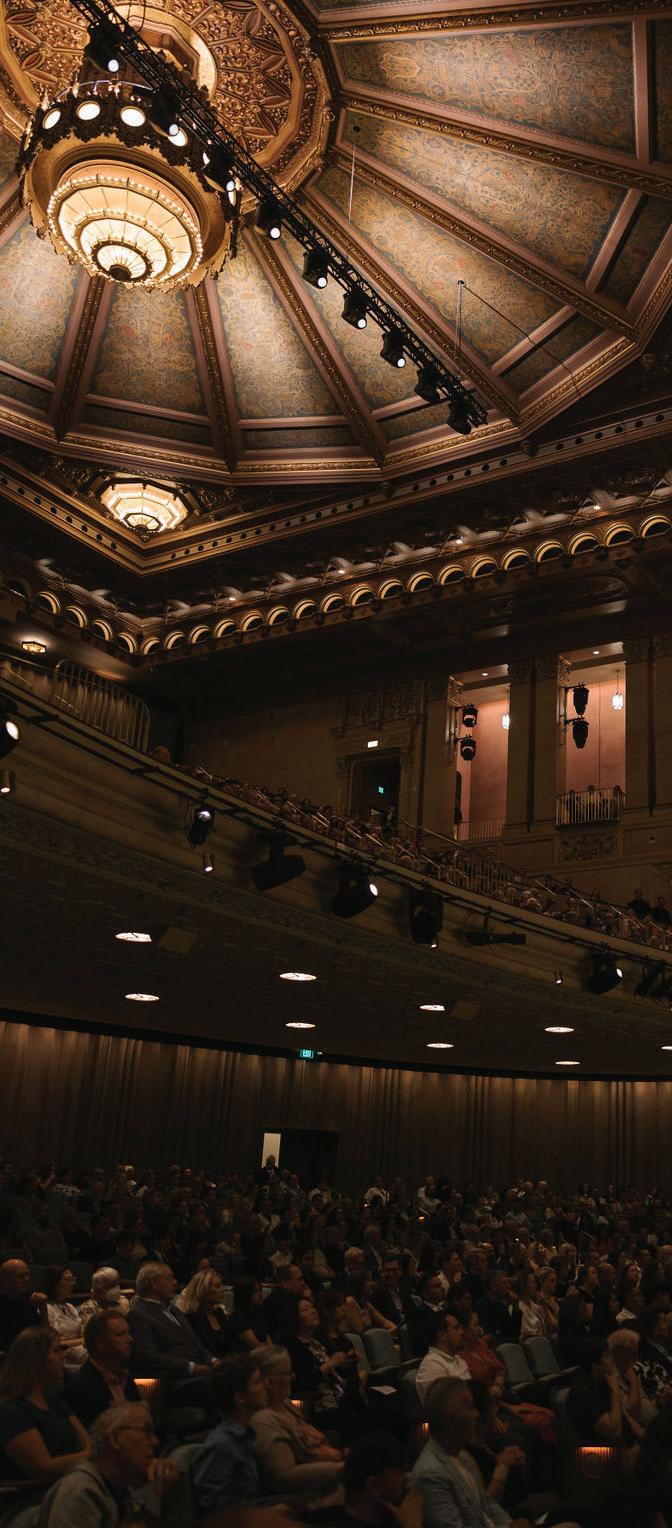

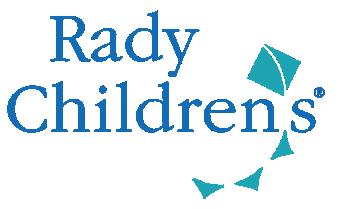
THESE PARTNERS CURRENTLY MAINTAIN AN ANNUAL SAN DIEGO SYMPHONY ORCHESTRA SPONSORSHIP:
$200,000+







$100,000+

$50,000+




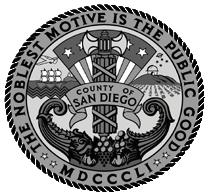


$25,000+

$15,000+






$10,000+



The San Diego Symphony Orchestra expresses sincere gratitude to the following donors for their generous contributions to the Symphony Summer Partners program. Our Summer Partners are a dedicated group of civicminded music-lovers who are committed to enriching our community through providing free music education and community engagement programs.
The following listing reflects pledges and gifts entered as of August 8, 2024.
$50,000
MR. LES J. SILVER AND ANDREA ROTHSCHILD-SILVER
$25,000
SHIRLEY ESTES
$15,000
GISELE BONITZ THE BOROS FAMILY
GORDON BRODFUEHRER
LINDA AND TOM LANG
CHRIS AND KRIS SEEGER
GAYLE AND PHILIP TAUBER
LISA AND MICHAEL WITZ
*Deceased

Becoming a Summer Partner of the San Diego Symphony affords you a unique opportunity to enhance your concert-going experience and support the inclusive and diverse programming that The Rady Shell at Jacobs Park has become known for. Your support as a Summer Partner is a commitment to the betterment of San Diego and the cultural excellence of our region.
For more information, or to join, please contact Vice President of Institutional Advancement, Sheri Broedlow at (619) 615-3910 or sbroedlow@sandiegosymphony.org
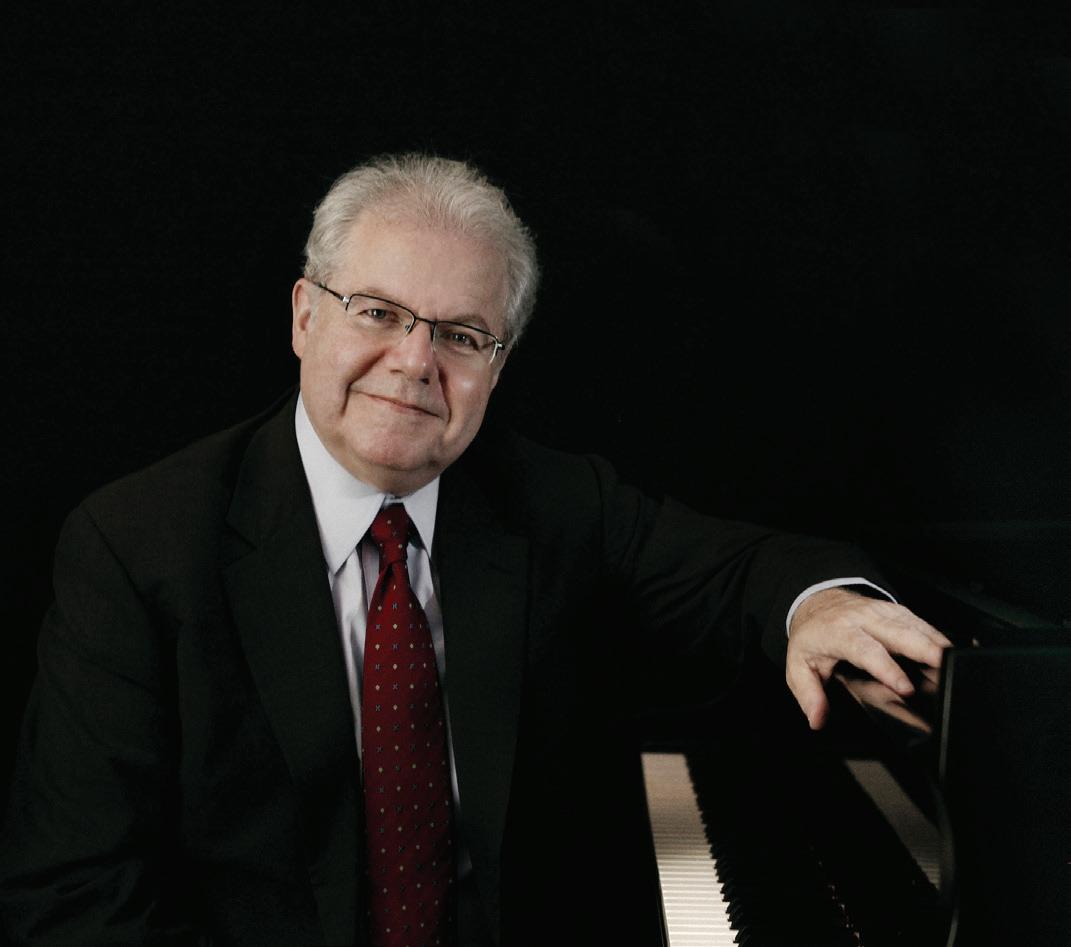
FRIDAY, OCTOBER 18 7:30PM
SATUDAY, OCTOBER 19 7:30PM
SUNDAY, OCTOBER 20 2 PM
Jacobs Music Center
2024 JACOBS MASTERWORKS
Rafael Payare, conductor
Emanuel Ax, piano
Giovanny Diaz de Leon, actor (Romeo)
Charlotte McBurney, actor (Juliet)
Gerard McBurney, director
Mike Tutaj, projections
Joel Shier, lighting designer
Tiffany Spicer Keys, lighting programmer
Joshua Heming, assistant lighting designer
San Diego Symphony Orchestra

MOZART
Piano Concerto No. 25 in C Major, K. 503
Allegro maestoso Andante Allegretto
Emanuel Ax, piano -INTERMISSIONPROKOFIEV
Excerpts from Romeo and Juliet, Op. 64 Ballet (G. McBurney compilation)
Total Program Duration: 2 Hours 10 Minutes (includes one, 20-minute intermission).
The San Diego Symphony is grateful to The Old Globe theater for their collaboration in casting of actors used in the design elements of this production.
Barry Edelstein, artistic director
Kim Heil, artistic producer and head of casting
VOICEOVER ACTORS :
Mahira Kakkar
Victor Morris
Gregg Mozgala
Gerardo Navarro
Emma Svitil
Cassia Thompson
Michael Underhill
Alejandra Villanueva
VIDEO ACTORS:
Alex Guzman
Madeline Grace Jones
Gerardo Navarro
Angelynne Pawaan
Akoni Steinmann
Emma Svitil
Cassia Thompson
Michael Underhill
See bio on page P5.

Born to Polish parents in what is today Lviv, Ukraine, Emanuel Ax moved to Winnipeg, Canada, with his family when he was a young boy. Mr. Ax made his New York debut in the Young Concert Artists Series, and in 1974 won the first Arthur Rubinstein International Piano Competition in Tel Aviv. In 1975 he won the Michaels Award of Young Concert Artists, followed four years later by the Avery Fisher Prize.
The 2024/25 season begins with a continuation of the Beethoven For Three touring and recording project with partners Leonidas Kavakos and Yo-Yo Ma which takes them to European festivals including BBC Proms, Dresden, Hamburg, Vienna and Luxembourg. As guest soloist he will appear during the New York Philharmonic’s opening week which will mark his 47th annual visit to the orchestra. During the season he will return to the Cleveland and Philadelphia orchestras, National, San Diego, Nashville and Pittsburgh symphonies and Rochester Philharmonic. A fall recital tour from Toronto and Boston moves west to include San Francisco, Seattle and Los Angeles culminating in the spring in Chicago and his annual Carnegie Hall appearance. A special project in duo with clarinetist Anthony McGill takes them from the west coast through the mid-west to Georgia and Carnegie Hall and in chamber music with Itzhak Perlman and Friends to Los Angeles, Santa Barbara and San Francisco. An extensive European tour will include concerts in Paris, Oslo, Cologne, Hamburg, Berlin, Warsaw and Israel.
Mr. Ax has been a Sony Classical exclusive recording artist since 1987 and following the success of the Brahms Trios with Kavakos and Ma, the trio launched an ambitious, multi-year project to record all the Beethoven Trios and Symphonies arranged for trio of which the first three discs have been released. He has received GRAMMY® Awards for the second and third volumes of his cycle of Haydn’s piano sonatas. He has also made a series of GRAMMY-winning recordings with Yo-Yo Ma of the Beethoven and Brahms sonatas for cello and piano. In the 2004/05 season Mr. Ax contributed to an International EMMY® Award-Winning BBC documentary commemorating the Holocaust that aired on the 60th anniversary of the liberation of Auschwitz. In 2013, Mr. Ax’s recording Variations received the Echo Klassik Award for Solo Recording of the Year (19th Century Music/Piano).
Mr. Ax is a Fellow of the American Academy of Arts and Sciences and holds honorary doctorates of music from Skidmore College, New England Conservatory of Music, Yale University, and Columbia University. For more information about Mr. Ax’s career, please visit EmanuelAx.com. n

Gerard McBurney is a British composer, writer, and deviser, working in theater, radio, television, and concert hall. Recent projects have included collaborations with Sir Mark Elder and the Hallé, the Southbank and Barbican Centres, Lincoln Center, the festivals in Lucerne and Aix-en-Provence, and with the Los Angeles Philharmonic, New York Philharmonic, and Philadelphia Orchestra. In May 2017, he was Creative Partner for the Cincinnati May Festival, directing productions of Mendelssohn’s A Midsummer Night’s Dream and Elgar’s The Dream of Gerontius. In January 2018, he made a new staging of The Genesis Suite for Sir Simon Rattle and the London Symphony Orchestra, and in August 2018, for the BBC Proms, a tribute to Leonard Bernstein, The Sound of an Orchestra, with the Royal Philharmonic Orchestraand Joshua Weilerstein.
Between 2006 and 2016, he was Artistic Programming Advisor at the Chicago Symphony Orchestra, and Creative Director of Beyond the Score®. More recently, he joined the San Diego Symphony as Artistic Consultant. Following his studies in the USSR in the 1980s, Gerard’s intense interest in Russian culture and music found a reflection in many of his own compositions. As an orchestrator, he is best known for his completions of lost and forgotten pieces by Shostakovich, including the unfinished opera about a monkey, Orango, which was given its world premiere in his version by Esa-Pekka Salonen and the Los Angeles Philharmonic in 2011. Upcoming work includes new collaborations with Sir Simon Rattle and the London Symphony Orchestra, with Esa-Pekka Salonen and the Philharmonia Orchestra and the Los Angeles Philharmonic, and, for Kirill Karabits and the Bournemouth Symphony Orchestra, the premiere of a lost melodrama by Liszt. n

MIKE TUTAJ
Mike Tutaj designs projections and sound for theatre and live performance. Based in Chicago, his designs have been seen and heard on the stages of The Goodman, Steppenwolf, The Chicago Symphony Orchestra, Chicago Shakespeare Theatre, The Second City, Lookingglass, TimeLine, Paramount Theatre, and many more. Off-Broadway credits include MCCTheater, p73, EnGarde Arts, and The York Theatre. Regional credits include Indiana Repertory Theatre, The Alliance Theatre, Philadelphia Theatre Company, South Coast Rep, Center Theatre Group, Children’s Theatre Company (Minneapolis), and Theatre Squared. International credits include productions with BBC Proms, The Holland Festival, The Aldeburgh Festival, and the London Symphony Orchestra. Mike teaches projection design at The Theatre School at DePaul University. He is an artistic associate with TimeLine Theatre, and a member of United Scenic Artists local 829. Love to Emily. www.miketutaj.com. n
Born January 27, 1756, Salzburg
Died December 5, 1791, Vienna
APPROXIMATE PERFORMANCE TIME 30 MINUTES
In the fall of 1786, the 30-year-old Mozart set to work simultaneously on two large-scale orchestral works: he completed the Piano Concerto in C Major on December 4 and a Symphony in D Major two days later; the symphony would assume the nickname “Prague” when it was premiered in that city the following month. There is, however, no record of the premiere of the concerto, nor is there any indication of the occasion for which it was written – this remains the least-known of the series of phenomenal piano concertos Mozart wrote in the years 1785-6. It lacks the seething power of the Concerto in D Minor, K. 466, the jaunty heroism of the Concerto in C Major, K. 467, the lyricism of the Concerto in A Major, K. 488, and the dark drama of the Concerto in C Minor, K. 491, and some have found it almost faceless in that distinguished company. The New Grove Dictionary, in fact, calls this concerto “almost neutral in character.”
These critics seem to have a point. The Concerto in C Major, K. 503 is not memorably lyric: its themes – built on triadic chords, scales and simple rhythmic motifs –feel almost static. But the wonder of this music is what Mozart does with his material, for this concerto shows him at his finest: its graceful interplay between soloist and orchestra, ingenious development of (seemingly) neutral ideas, and contrapuntal ease make the Concerto in C Major one of his most subtle and affecting scores.
The opening Allegro maestoso is aptly named: this truly is majestic music, and it leaps to life with one of Mozart’s grandest openings, punctuated by the sound of trumpets and drums. Yet this massive opening is built simply on C Major chords, almost static in themselves, and only incidentally does Mozart introduce the rhythmic motif that will shape and unify so much of this music. (This pattern of three eighths and a downbeat would later become famous as the opening of Beethoven’s Fifth Symphony, but it haunted Mozart as well.) A further surprise is the entrance of the piano: after the mighty orchestral opening – with its powerful chords, rushing scales and C-minor modulations – the piano makes what seems an understated entrance, slipping in almost shyly. It has been noted that this movement manages to be heroic while avoiding any trace of struggle: there are no battles fought and won here, but instead an air of serenity, a carefree exultation in sophisticated music-making as Mozart transforms simple materials into music of charm and grace over an unusually long span. (This is in fact the longest movement in any Mozart concerto.)
The subsequent movements partake of the same spirit and technique, though on a smaller scale. The Andante,
relaxed and reflective, features some of Mozart’s sensitive writing for woodwinds. The piano part, gentle as it is, is marked by some unusually wide skips, particularly the upward leap of a tenth. Along the way, alert listeners will recognize the same rhythmic motif that underlay the first movement. The finale is rondo-like in structure, but with some important variations. Mozart borrowed its central theme from the ballet music to his opera Idomeneo, composed six years earlier, though here that tune makes few literal returns. Rather, it is subtly varied in a movement that seems more a series of continuous variations than the standard rondo process of literal repetition. In this movement, Mozart combines some of the reflective quality of the Andante with the C-Major trumpet-and-drum fanfares of the opening movement.
Some scholars have gone so far as to suggest that Mozart deliberately made the thematic material of this concerto neutral as a way of shifting interest away from the themes and onto what he does with them; this may explain the unusual length of the development in the first movement. In any case, while the Concerto in C Major may not have achieved the popularity of some of Mozart’s other piano concertos, it remains – in its subtle and expressive way – one of his finest creations. n

Born April 23, 1891, Sontsivka, Ukraine
Died March 5, 1953, Moscow
APPROXIMATE PERFORMANCE TIME
1 HOUR 20 MINUTES
Program Note from the Desk of: Gerard Mcburney Prokofiev was still a young man when he left Russia, a few months after the Bolshevik Revolution in the autumn of 1917. World war and political upheaval meant there were few prospects for a musician in his native land. After a madcap trip across Asia and through Japan, he moved to the United States and, a year or two later, to Western Europe.
As things began to settle down in the later 1920s, however, he started to receive invitations to travel and perform in what was now the USSR. Soon that led to lucrative commissions from Soviet cultural authorities, culminating in the mid 1930s with a request for a fulllength ballet on the story of Shakespeare’s tragedy Romeo and Juliet
Prokofiev worked with two colleagues to create a simplified version of Shakespeare’s complicated plot, omitting many of the characters and including plentiful crowd scenes which would allow the corps de ballet to show off their skills. The result was one of the greatest ballet-scores of the mid-20th century, today rarely out of the repertoire of the world’s principal ballet companies.
Some of the most beautiful and personal music in this score is, naturally enough, for the scenes between the protagonists of the title. Remember: in Shakespeare’s play Juliet is only 13 years old, and Romeo just 3 years older than that. In modern terms, just children, far below the age we would nowadays consider it acceptable to marry, though in Shakespeare’s time marriage at such an age was more normal.
Prokofiev always had a gift for writing music for and about children – think of Peter and the Wolf and his Seventh Symphony – and in this music the composer captures something remarkable, at once touchingly innocent and at the same time extremely passionate in a way we would nowadays think of as decidedly not childlike.
This performance, specially created for the San Diego Symphony Orchestra and the opening of our new Jacobs Music Center, gathers together all the music from the score which focuses our attention on the two young lovers and what happens to them, and interweaves Prokofiev’s 20th century Russian music with the astonishingly beautiful late 16th century English lovepoetry – including some of the most famous and inspiring lines that Shakespeare ever wrote – to create a tribute to
both great artists (who lived 350 years apart from one another and in quite different countries), and retell once again one of the world’s most famous love-stories in a way that reminds us of the haunting beauties of both the words and music.
At the same time, this performance has been imagined so as to reveal the astonishing musical, spatial and theatrical possibilities of this amazing new hall, to celebrate the achievement of this architectural and musical reimagining, and enable us to hear this famous orchestral music and these famous words in a way that has never been tried before. n
-Program notes by Eric Bromberger




“To have the opportunity to improve the beautiful hall we call home, and to improve the musical communication on stage with the musicians, and to create a more intimate connection with our audiences, is a fantastic dream.”
– Rafael Payare, Music Director, San Diego Symphony
Under the leadership of Music Director Rafael Payare and Chief Executive Officer Martha Gilmer, the San Diego Symphony has completed a historic renovation of its indoor home. The renovation of The Joan and Irwin Jacobs Music Center complements The Rady Shell at Jacobs Park and provides San Diego with two extraordinary venues designed to celebrate music and community. Likewise, in the same way that these venues promise an ever-brighter future, the San Diego Symphony Foundation’s endowment provides longterm financial stability for the organization, ensuring that the power of live music continues to inspire and uplift our community for generations to come.
The San Diego Symphony Foundation manages our Endowment, the cornerstone of our long-term stability and artistic excellence. By contributing to the Endowment, donors play a crucial role in sustaining our orchestra’s ability to present worldclass performances, expand our educational outreach, and foster innovation in the arts. We invite you to join us in this enduring legacy by supporting the Endowment, securing the future of music in San Diego, and leaving an indelible mark on our cultural landscape.




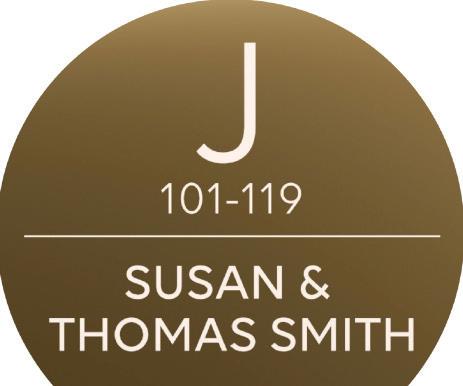






The beauty of the newly renovated Jacobs Music Center will be most enjoyed from the reconfigured seating in the hall. We ask you to join this historic campaign by investing in the San Diego Symphony and NAMING A SEAT. The named seats serve as a celebration of all individuals who helped make the renovation possible. With a gift of $10,000, you can name a seat on the Orchestra level, or with a gift of $25,000, you can name a seat in the Grand Tier. Your contribution can be pledged and paid over a period of one to five years.
A gift toward the renovated Jacobs Music Center supports the orchestra, elevates the audience experience, and impacts the growing vitality of downtown San Diego. To learn more, send an email to: campaign@sandiegosymphony.org

FRIDAY, OCTOBER 25 7:30PM
SATURDAY, OCTOBER 26 7:30PM
Jacobs Music Center
2024 JACOBS MASTERWORKS
Antonio Méndez, conductor
Paul Huang, violin
San Diego Symphony Orchestra

MENDELSSOHN
Overture to Ruy Blas, Op. 95
BRUCH
Violin Concerto No. 1 in G minor, Op. 26
Vorspiel; Allegro moderato
Adagio
Finale: Allegro energico
Paul Huang, violin -INTERMISSION-
TCHAIKOVSKY
Symphony No. 5 in E minor, Op. 6
Andante - Allegro con anima
Andante cantabile con alcuna licenza
Valse: Allegro moderato
Finale: Andante maestoso - Allegro vivace
Total Program Duration: 1 Hour 20 Minutes (includes one, 20 minute intermission).

ANTONIO MÉNDEZ
Spanish conductor Antonio Méndez is fast becoming one of the most exciting, established and sought-after conductors, having created strong links with the most important orchestras in Europe.
Over the last few years, Antonio has had great success conducting orchestras such as Tonhalle-Orchester Zürich, Symphonieorchester des Bayerischen Rundfunks, Mahler Chamber Orchestra, Rotterdam Philharmonic Orchestra, Danish National Symphony Orchestra, hr-Sinfonieorchester, Wiener Symphoniker and Orchestre Philharmonique du Luxembourg.
This season, he will perform with San Diego Symphony Orchestra, Iceland Symphony Orchestra, Orchestra Ensemble Kanazawa, Gunma Symphony Orchestra, Orquesta Sinfónica del Principado de Asturias, Orquestra de les Illes Balears, and Orchester des Pfalztheaters Kaiserslautern among ot hers.
In the past season, Antonio debuted with La Monnaie / De Munt, Brucknerhaus Linz, Lahti Symphony Orchestra, Northern Sinfonia, San Diego Symphony Orchestra, Real Orquesta Sinfónica de Sevilla and RST Symphony Orchestra among others. Highlights of recent seasons include acclaimed debuts with Wiener Symphoniker, Tonkünstler-Orchester Niederösterreich, Konzerthausorchester Berlin, Staatskapelle Dresden, Gürzenich-Orchester Köln, BBC Philharmonic, Orchestra de Chambre de Paris, Helsinki Philharmonic Orchestra, Iceland Symphony Orchestra, Orchestre de Chambre de Lausanne, Russian National Orchestra, KBS Symphony Orchestra, Auckland Philharmonia Orchestra, New Japan Philharmonic and a tour with Orchestre de Chambre de Paris to the Canary Islands.
Also working in opera over recent seasons, Méndez has conducted The Turn of the Screw at La Monnaie / De Munt, Ariadne auf Naxos at the Canary Islands Music Festival, 7 Deaths of Maria Callas – a show that combines opera, live arts, performance art and video creation – at Gran Teatre del Liceu, Madame Butterfly at the Palma de Mallorca Opera House and L’Elisir d’Amore at the Tenerife Opera House. Antonio held the post of Principal Conductor of Orquesta Sinfónica de Tenerife from the 2018/19 to 2020/21 season.
Antonio’s recording with Radio-Sinfonieorchester Stuttgart des SWR on SWR Music (for Berlin Classics) was awarded an Echo Klassik Award. He has also recorded with Scottish Chamber Orchestra for Linn Records.
The artist attracted international attention as a prize winner at the prestigious 2012 Malko Competition in Copenhagen, and later as a finalist at the 2013 Nestlé and Salzburg Festival Young Conductors Award.
Born in 1984 in Palma de Mallorca, Antonio began his musical studies at the Conservatori Professional de Música de Mallorca in piano and violin. He also attended the Real Conservatorio Superior de Música de Madrid to study composition and conducting. Since 2007 he has
been living in Germany, where he completed his conductor training at the Universität der Künste Berlin with Professor Lutz Köhler, also as a member of the Dirigentenforum (‘Conductor’s Forum’ from the German Music Council) and at the Hochschule für Musik ‘Franz Liszt’ Weimar with Professor Nicolás Pasquet.

Recipient of the prestigious 2015 Avery Fisher Career Grant and the 2017 Lincoln Center Award for Emerging Artists, violinist Paul Huang is considered to be one of the most distinctive artists of his generation. The Washington Post remarked that Mr. Huang “possesses a big, luscious tone, spot-on intonation and a technique that makes the most punishing string phrases feel as natural as breathing,” and further proclaimed him as “an artist with the goods for a significant career” following his recital debut at the Kennedy Center.
Known for his “unfailing attractive, golden, and resonant tone” (The Strad), Mr. Huang’s recent highlights have included acclaim debut at Bravo!Vail Music Festival stepping in for violinist Anne-Sophie Mutter in the Mozart’s Violin Concerto No.4 with Chamber Orchestra Vienna-Berlin, Rotterdam Philharmonic with Lahav Shani, Detroit Symphony with Leonard Slatkin, Houston Symphony with Andres Orozco-Estrada, Baltimore Symphony and Seoul Philharmonic with Markus Stenz, and recital debuts at the Lucerne Festival in Switzerland and Aspen Music Festival. In Fall 2021, Paul also became the first classical violinist to perform his own arrangement of the National Anthem for the opening game of the NFL at the Bank of America Stadium in Charlotte, North Carolina to an audience of 75,000. An exclusive recording artist with France’s Naïve Records, his debut album “Kaleidoscope” was released worldwide in October of 2023. His recording of Toshio Hosokawa’s Violin Concerto “Genesis” with Residentie Orkest Den Haag will be released on NAXOS in June of 2024.
During the 2023-24 season, Mr. Huang appears with the National Symphony Orchestra of Taiwan with Jun Markl, Pacific Symphony with Matthew Halls, and makes debuts with Dallas Symphony Orchestra and NHK Symphony with Fabio Luisi, Vancouver Symphony with Otto Tausk, and San Francisco Symphony with Mei-Ann Chen. Other highlights will include engagements with the Colorado Springs Philharmonic, Brevard, and Augusta Symphonies.
2023-24 season recital, chamber music, and festival performances will include Mr. Huang’s return to both the Chamber Music Society of Lincoln Center and Camerata Pacifica, and his much anticipated recital return at the Kennedy Center (Washington Performing Arts presents) and his recital debut in Singapore at the Victoria Concert Hall. Mr. Huang will also return to Bravo!Vail, North Shore, and Rockport Music Festivals. In January 2024, Mr. Huang will launch the 2nd edition of “Paul Huang & Friends” International Chamber Music Festival in Taipei, Taiwan, in association with the National Symphony Orchestra of Taiwan.
Mr. Huang’s recent recital engagements included Lincoln Center’s “Great Performers” series and debuts at the Wigmore Hall, Seoul Arts Center, and the Louvre in Paris. A frequent guest artist at music festivals worldwide, he has performed at the Seattle, Music@Menlo, Savannah, Caramoor, La Jolla, Santa Fe, Moritzburg, Kissinger Sommer, Sion, Orford Musique, and the PyeongChang Music Festival in South Korea. His chamber music collaborators have included Gil Shaham, Cho-Liang Lin, Nobuko Imai, Mischa Maisky, Jian Wang, Lynn Harrell, Yefim Bronfman, Kirill Gerstein and Marc-Andre Hamelin. Winner of the 2011 Young Concert Artists International Auditions, Mr. Huang made critically acclaimed recital debuts in New York at Lincoln Center and in Washington, D.C. at the Kennedy Center. Other honors include First Prize at the 2009 Tibor Varga International Violin Competition Sion-Valais in Switzerland, the 2009 Chi-Mei Cultural Foundation Arts Award for Taiwan’s Most Promising Young Artists, the 2013 Salon de Virtuosi Career Grant, and the 2014 Classical Recording Foundation Young Artist Award.
Born in Taiwan, Mr. Huang began violin lessons at the age of seven. He is a recipient of the inaugural Kovner Fellowship at The Juilliard School, where he earned his Bachelor’s and Master’s degrees under Hyo Kang and I-Hao Lee. He plays on the legendary 1742 “ex-Wieniawski” Guarneri del Gesù on extended loan through the Stradivari Society of Chicago and is on the faculty of Taipei National University of the Arts. He resides in New York. n
Born February 3, 1809, Hamburg
Died November 4, 1847, Leipzig
APPROXIMATE PERFORMANCE TIME 7 MINUTES
Early in March 1839, the Leipzig Theatrical Pension Fund planned to produce Victor Hugo’s play Ruy Blas, which had been premiered only four months earlier in Paris, and they asked Felix Mendelssohn to compose an overture to launch the play. But there was a problem: Mendelssohn read the play, and he hated it, calling it “entirely repulsive and beneath all dignity.” Not wishing to offend the fund, he composed a brief romance for sopranos and strings but begged off writing the overture, saying that he didn’t have the time (and in this he was quite correct: only three weeks later he would conduct the premiere of the recently discovered Schubert Ninth Symphony). The Pension Fund sent him a very graceful note, thanking him for the romance and saying that they understood that it was impossible to write an overture on such short notice. Apparently that note went straight up Mendelssohn’s nose: he sat down and wrote the overture in three days, just to show them that he could do it. He handed the manuscript to his copyist on March 8, and that copyist also worked in a hurry: the overture was premiered on March 11 at the start of the play.
Hugo’s play tells of a servant who suddenly becomes prime minister in the court of Charles II of Spain in 1699; he enacts humane reforms but dies during the play’s bloody denouement. We need know none of this to enjoy Mendelssohn’s overture – he made no attempt to depict the events of the play, and his overture should be enjoyed as a piece of abstract music. It begins quite solemnly, with deep C-minor chords from the orchestra’s winds, which are answered by fast and twisting responses from the strings. These string figures turn into the overture’s principal theme, which leaps ahead at the Molto allegro, but the ominous wind chords return throughout, and the overture eventually drives to a grand, brassy climax in C Major.
Mendelssohn may have hated the play, but he liked his own overture, which is an effective curtain raiser for any occasion. He conducted it a number of times over the following years, but at those concerts it was not called the Overture to Ruy Blas – Mendelssohn insisted that the name for this piece should be the Theatrical Pension Fund Overture. n
Born January 6, 1838, Cologne
Died October 2, 1920, Berlin-Friedenau
APPROXIMATE PERFORMANCE TIME 24 MINUTES
Max Bruch appears fated to remain a one-work composer. His choral compositions are still admired in Germany, and one hears the Scottish Fantasy from time to time, but Bruch’s reputation today rests squarely on the fame of one work, his First Violin Concerto. Ironically, this concerto was a product of his youth – he began work on it at age 19, finished the first version nine years later, and had it in final form in 1868, when he was only 30. Joseph Joachim, the dedicatee, gave the successful premiere of this version, and the concerto’s instant popularity overwhelmed everything else Bruch wrote thereafter. He is said to have reacted with exasperation when young violinists came to play for him, for they always played this concerto. He was left complaining that he had written some other pieces for violin.
There are several good reasons for this concerto’s continuing popularity. Bruch writes gorgeous melodies for the violin here – this is late German romanticism at its most lyric. He is then able to build these simple melodies into climaxes of tremendous power and excitement. Last, and certainly not least, this concerto is beautifully written for the violin – it sits gracefully under the fingers, and while the Concerto in G minor is very difficult, it is also very grateful to play. This concerto has an evergreen quality that will keep it fresh forever.
The form is slightly unusual, and the opening movement gave Bruch a great deal of trouble. The first two movements are joined, and Bruch worried
that the opening section was not a complete movement. He called it Vorspiel (Prelude), and it is in an unusual form. It begins with a slow orchestral introduction, and the violin enters with a cadenza-like recitative. The music soon rushes ahead on soaring themes and dramatic writing to a great climax, and then Bruch brings back the recitative of the very beginning to lead the way into the middle movement.
The Adagio is one of the great slow movements in all the violin concerto literature, and it shows Bruch’s considerable melodic gift. There are three separate themes, all gentle and yearning, and all of them wellsuited to the violin’s lyrical nature. Bruch weaves them into a climax of considerable power before the movement ends quietly. The finale, aptly marked Allegro energico, is a rondo-like movement in G Major. The orchestra’s introduction leads to the impressive violin entrance, reminiscent of gypsy fiddling. Once again, Bruch offers some terrific writing for the violin, and his performance markings tell the tale: passages marked appassionato or con fuoco or con forza alternate with material marked dolce or tranquillo e grazioso. The movement races to its close on a Presto coda that sends the solo violin soaring to the very top of its range. n
PYOTR ILYICH TC HAIKOVSKY
Born May 7, 1840, Votkinsk
Died November 6, 1893, St. Petersburg
APPROXIMATE PERFORMANCE TIME 44 MINUTES
In the winter of 1887-88 Tchaikovsky made a tour of Western Europe, conducting his own works in Leipzig, Hamburg (where he met Brahms), Berlin, Prague, Paris and London. Those audiences responded enthusiastically to his music (Brahms was an exception), and Tchaikovsky returned to Russia ready to attempt a new symphony. In April 1888 he moved into a villa in Frolovskoye, northwest of Moscow, where he could work on his new symphony and take long walks in the woods. Two years later he would return to Frolovskoye to discover – in a moment straight out of Chekhov – that the forests had all been cut down, but now he worked happily in this beautiful setting, and his Fifth Symphony was done by August. Tchaikovsky led the premiere in St. Petersburg on November 17, 1888.
While it lacks the white-hot fury of the Fourth Symphony or the dark intensity of the Sixth, the Fifth Symphony –full of those wonderful Tchaikovsky themes, imaginative orchestral color and excitement – has become one of his most popular works, so popular in fact that it takes a conscious effort to hear this symphony with fresh ears. As he did in the Fourth, Tchaikovsky builds this symphony around a motto-theme, and in his notebooks he suggested that the motto of the Fifth Symphony represents “complete resignation before fate.” But that is as far as the resemblance goes, for Tchaikovsky
supplied no program for the Fifth Symphony, nor does this music seem to be “about” anything. The motto theme returns in each of the four movements, often in quite different guises, but it may be best to understand this motto as a unifying device rather than as anything so dramatic as the Fourth Symphony’s “sword of Damocles.” Listeners are of course free to supply their own interpretations as to what this music is about, but despite the tantalizing hints about “resignation before fate,” Tchaikovsky apparently regarded his Fifth Symphony as abstract music.
Clarinets introduce the somber motto-theme at the beginning of the slow introduction, and gradually this leads to the main body of the movement, marked Allegro con anima. Over the orchestra’s steady tread, solo clarinet and bassoon sing the surging main theme of this sonata-form movement, and there follows a wealth of thematic material. This is a lengthy movement, and it is built on three separate-theme groups, full of soaring and sumptuous Tchaikovsky melodies. The development fuses these lyric themes with episodes of superheated drama, and listeners will hear the motto-theme hinted at along the way. The movement draws to a quiet close, its furious energy finally exhausted.
Deep string chords at the opening of the Andante cantabile introduce one of the great solos for French horn, and a few moments later the oboe has the graceful second subject. For a movement that begins in such relaxed spirits, this music is twice shattered by the return of the motto-theme, which blazes out dramatically in the trumpets. Tchaikovsky springs a surprise in the third movement – instead of the expected scherzo, he writes a lovely waltz. Its trio section skitters along a steady flow of sixteenth-notes from the strings (this section feels very much like a scene from one his ballets), and Tchaikovsky rounds the movement off beautifully – he writes an extended coda based on the waltz tune, and in its closing moments the motto-theme makes a fleeting appearance, like a figure seen through the mists.
However misty that theme may have seemed at the end of the third movement, it comes into crystalline focus at the beginning of the finale. Tchaikovsky moves to E Major here and sounds out the motto to open this movement – this music seems to have arrived at its moment of triumph even before the last movement has fairly begun. The main body of the finale, marked Allegro vivace, leaps to life, and the motto-theme breaks in more and more often as it proceeds. The movement drives to a great climax, then breaks off in silence. This is a trap, designed to trick the unwary and propel them into premature applause, for the symphony is not yet over. And in fact no attentive listener should be fooled, for this false “conclusion” is in the “wrong” key of B Major! (One wonders just what thoughts were running through Tchaikovsky’s mind when he designed this trap.) Out of the ensuing silence begins the real coda, and the mottotheme now leads the way on constantly-accelerating tempos to the (true) conclusion in E major. n
-Program notes by Eric Bromberger
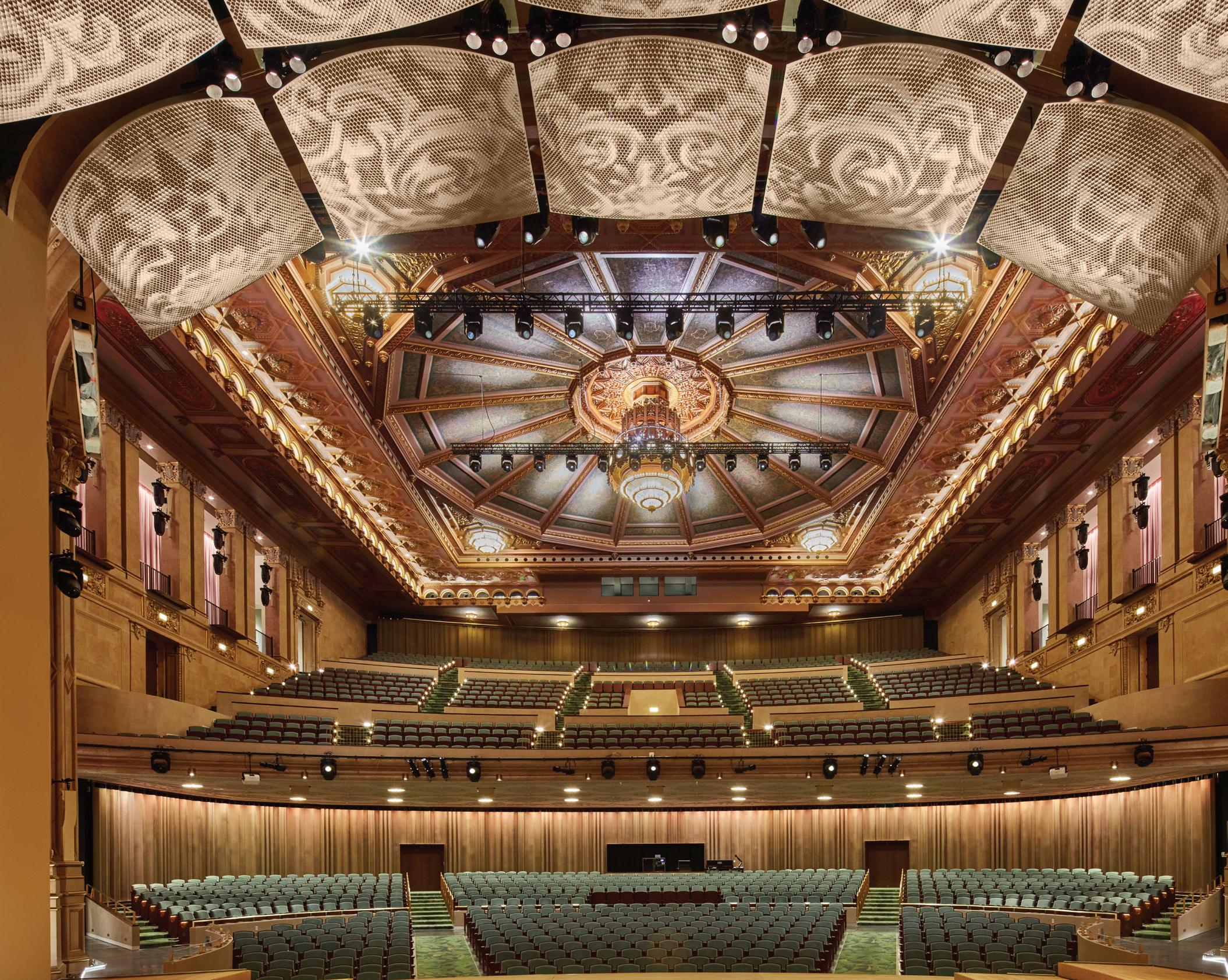
UC San Diego is proud to be the Official Education and Community Engagement Sponsor of the San Diego Symphony.

The San Diego Symphony is proud to announce that we have met our goal of $125 million for The Future is Hear Campaign! This extraordinary campaign supports construction of The Rady Shell at Jacobs Park, improvements to Jacobs Music Center, and wide-ranging artistic initiatives for San Diego's communities.
If you'd like to support The Rady Shell at Jacobs Park, please contact us at campaign@sandiegosymphony.org for giving and recognition opportunities.


We gratefully acknowledge our Guest Artist Sponsors. Please call (619) 615-3910 to participate!
ALAN BENAROYA
DAVID BIALIS
BROOKE KOEHLER
THE BJORG FAMILY
VAIL MEMORIAL FUND, MEREDITH BROWN, TRUSTEE
DOROTHEA LAUB

San Diego Symphony is pleased to have Sycuan Casino Resort as the lead sponsor of the Music Connects Community Concerts!
Bird Singers from the Sycuan Band of the Kumeyaay Nation performing at the opening of a San Diego Symphony Community Concert on stage at Live & Up Close | Sycuan Casino Resort.

The San Diego Symphony Orchestra acknowledges the following donors who have made a gift of $10,000 or more toward The Future is HEAR campaign, our current $125 million campaign supporting the San Diego Symphony’s construction of The Rady Shell at Jacobs Park and its wide-ranging artistic and community programs. We are extremely grateful! To make a gift, please call (619) 237-1969. The following listing reflects pledges or gifts entered as of August 8, 2024.

San Diego Foundation Rancho Santa Fe Foundation Jewish Community Foundation ◊ Deceased
$1,000,000 AND ABOVE
Terry L. Atkinson
Bank of America
Dianne Bashor
Malin and Roberta Burnham
Harry and Judy Collins Foundation
Daniel J. and Phyllis Epstein
Ted and Audrey Geisel◊
The George Gildred Family and The Philip Gildred Family
Joan◊ and Irwin Jacobs
Sheri Lynne Jamieson
The Kong Tang Family
Dick◊ and Dorothea Laub
Jack McGrory
The Alexander and Eva Nemeth Foundation
The Conrad Prebys Foundation
Allison and Robert Price
Evelyn and Ernest Rady
Lou and Penny Rosso and the Rosso Family
Colette Carson Royston and Ivor Royston
Sahm Family Foundation
T. Denny Sanford
Karen and Christopher “Kit” Sickels
Karen and Jeff Silberman
Donald and Gayle◊ Slate
The State of California
Gloria and Rodney Stone
Sycuan Casino Resort
Roger◊ Thieme and Sylvia Steding
Sue and Bill◊ Weber
$250,000 AND ABOVE
Anonymous
Raffaella and John Belanich
Alan Benaroya
Susan and Jim Blair
The James Silberrad Brown Foundation
Julia Brown Family
David C. Copley Foundation
Sam B. Ersan◊
Esther Fischer
Pam and Hal Fuson
Karen and Warren Kessler
Carol Ann and George Lattimer
The Payne Family Foundation
M&I Pfister Foundation
Linda and Shearn◊ Platt
Robert Glenn Rapp Foundation
Dave and Phyllis Snyder
Elaine Galinson and Herbert Solomon
Elizabeth and Joseph◊ Taft
Jayne and Bill Turpin

Kathryn A. and James E. Whistler
$100,000 AND ABOVE
Jules and Michele Arthur
Denise and Lon Bevers
David Bialis
Catherine & Phil Blair, Linda & Mel Katz, Manpower San Diego
Nikki and Ben Clay
Stephanie and Richard Coutts
Diane and Charles Culp
Diane and Elliot Feuerstein
Walt Fidler
Anne and Steve Furgal
Lisa Braun Glazer and Jeff Glazer
Linda & Melvyn Katz
In memory of Jim Lester
The Hering Family
Carol and Richard Hertzberg
Arlene Inch
Brooke and Dan◊ Koehler
Bill and Evelyn Lamden
Curt Leland and Mary DiMatteo
Sandra and Arthur◊ Levinson
The Alex C. McDonald Family
Lori Moore, Cushman Foundation
The Parker Foundation (Gerald T. & Inez Grant Parker)
Bill and Clarice Perkins
Marilyn James and Richard Phetteplace
Jeanne and Arthur◊ Rivkin
Sage Foundation
In memory of Bob Nelson who loved the music, the bay and San Diego
Tucker Sadler Architects
U.S. Bank
Jo and Howard◊ Weiner
Cole and Judy Willoughby
Richard◊ and Joanie Zecher
$50,000 AND ABOVE
Carol Rolf and Steven Adler
Bonnie & Krishna Arora and Family
David A. and Jill Wien Badger
Carolyn and Paul Barber
Cindy and Larry Bloch
Lisa and David Casey
The John D. & Janice W. Cone Family Trust
Scotty Dale
Kathleen Seely Davis
The den Uijl Family
In Loving Memory of LV
Gary and Karin Eastham
In loving memory of Kenrick “Ken” Wirtz◊
Jose Fimbres Moreno◊
Karen Wahler and Michael Gay◊
William and Martha Gilmer
The Jaime Family Trust
Roy, Peggy, Dean, and Denise Lago
The Peggy and Robert Matthews Foundation
Admiral Riley◊ D. Mixson
Gerry and Jeannie Ranglas
Marilyn & Michael Rosen, Juniper and Ivy Restaurant
Richard Sandstrom and Sandra Timmons
Congresswoman Lynn Schenk
Kris and Chris Seeger
Deborah Heitz and Shaw Wagener
Emma and Leo Zuckerman
$25,000 AND ABOVE
Anonymous
Lisa and Dennis Bradley
Gordon Brodfuehrer
Pamela and Jerry Cesak
County of San Diego
The Druck/Silvia Family
Susan E. Dubé
Lisette & Mick Farrell
Dr. John and Susan Fratamico
Janet and Wil Gorrie
Virginia and Peter Jensen
Jeff Light and Teri Sforza
Sig Mickelson◊
Sandy and Greg Rechtsteiner
The Segur Family
In honor of Robert (Bud) Emile, SDS Concertmaster 1960-1975
Bill and Diane Stumph
Gayle and Philip Tauber
In memory of my husband
Raymond V. Thomas, Lover of the Symphony
The Bartzis-Villalobos Family
RANAS
Leslie and Joe Waters
John J. Zygowicz and Judy Gaze Zygowicz
$10,000 AND ABOVE
Erina Angelucci
Aptis Global, A subsidiary of The Kimball Group
DeAnne Steele, Carlo Barbara and Cole Barbara
Eloise and Warren Batts
Lauren Lee Beaudry
Karl and Christina Becker
Edgar and Julie Berner
Diane and Norm Blumenthal
The Boros Family
Sarah◊ and John Boyer
Annette and Daniel Bradbury
Lori and Richard Brenckman
Sheri Broedlow and Kyle Van Dyke
Beth Callender & Pete Garcia
Robert Caplan and Carol Randolph, Seltzer Caplan McMahon Vitek
The Casdorph Family
Angela Chilcott
Kurt and Elizabeth Chilcott
Dr. Samuel M. Ciccati and Kristine J. Ciccati
Thomas Jordan and Meredith M. Clancy
P. Kay Coleman & Janice E. Montle
Dr. William Coleman
Peter V. Czipott and Marisa SorBello
Ann Davies
Caroline S. DeMar
Drs. Edward A. and Martha G. Dennis
George & Jan DeVries
Robert and Nina Doede
In loving memory of Karen Cooper Ferm◊
Michael and Susan Finnane
Gertrude B. Fletcher
K. Forbes
Deborah Pate and John Forrest
4040 AgencyMary, Bill & John
Judith and William Friedel
Barbara and Doug Fuller
Cheryl J. Hintzen-Gaines and Ira J. Gaines
Vicki Garcia-Golden and Tim Jeffries, Gardiner & Theobald Inc.
Joyce M. Gattas, PhD
Lynn and Charlie Gaylord
In memory of Royce G. Darby◊
Kimberly and Jeffrey Goldman
In memory of Samuel Lipman◊Clarinetist
The Granada Fund
Robert and Carole Greenes
Carrie and Jim Greenstein
Georgia Griffiths and Colleen Kendall
Lulu Hadaya
Jeff and Tina Hauser
In memory of Lucille Bandel◊
In Memory of Dick Hess◊
Richard A. Heyman and Anne E. Daigle Family Foundation
Let the music play on, Drew!
Mary Ann and John Hurley
Cynthia Thornton and Michael Keenan
Keith and Cheryl Kim
Katherine Kimball
Helen and Sig Kupka
Linda and Tom Lang
Alexis and Steven Larky
Tom and Terry Lewis Foundation
The Li Family
Larry Low and Mikayla Lay
Josephine & Alex Lupinetti◊
Scott MacDonald and Patti Kurtz
Daniel and Chris Mahai
Sally and Luis Maizel
Susan and Peter Mallory, in honor of Martha Gilmer
David Marchesani Family
Anne and Andy McCammon
The McComb Family
Katy McDonald
Larry McDonald and Clare White-McDonald
Mark, Amy, Auguste & Paris Melden
In Memory of James C. Moore◊
Judith and Neil Morgan
Clara and Donald Murphy
Patricia R. Nelson
The Lorna◊ & Adrian Nemcek Family
The Ning Family
Frank O’Dea O’Dea Hospitality
Val and Ron Ontell
Carol and Vann Parker
The Hong-Patapoutian Family
The Pollock Family
The Quintilone and Cooper Families
Phillip Rand, M.D., dedicated Ob-Gyn, kind and gentle soul, humanitarian
In loving memory of Long “Chris” Truong◊
Dr. Vivian Reznik and Dr. Andrew Ries
Burton X and Sheli Rosenberg
Marie G. Raftery and Dr. Robert Rubenstein

The Ryde Family Memorial Foundation at The San Diego Foundation
Shari and Frederick Schenk
Colin Seid and Dr. Nancy Gold
Susan and Michael Shaffer
Brigg and Jayne Sherman
Shinnick Family
Ruey & Marivi Shivers
Stephen M. Silverman
Janet Simkins
Hon. Stephanie Sontag and Hon. David B. Oberholtzer
Jeanette Stevens
Sudberry Properties
Beatriz & Matthew Thome
Katherine “Kaylan” Thornhill
Jacqueline Thousand and Richard Villa
Glenda Sue Tuttle
Michael and Eunicar Twyman
Susan and Richard Ulevitch
Aysegul Underhill
Patricia and Joe Waldron
Lori and Bill◊ Walton
The Warner Family

The K. Nikki Waters Trust
Shirli, Damien and Justin Weiss
Mike and Susan Williams
Jeffrey P. Winter and Barbara Cox-Winter
The Witz Family
In loving memory of Ching H. Yang
Howard and Christy Zatkin
The Legacy Society honors the following individuals who have made cash pledges or future commitments from their estates to the San Diego Symphony Foundation and/or the San Diego Symphony Orchestra Association to ensure the success of the orchestra for generations to come. The following listing includes commitments as of August 8, 2024
$1,000,000 AND ABOVE
Sophie & Arthur Brody Foundation
Nikki A. and Ben G. Clay
Daniel J. and Phyllis Epstein
John Forrest and Deborah Pate
Elaine Galinson and Herbert Solomon
Norman Forrester and Bill Griffin
Pauline Foster*
Pamela Hamilton Lester In Memory of Jim Lester
Joan* and Irwin Jacobs
Karen and Warren Kessler
Willis J. Larkin*
Beatrice P. and Charles W. Lynds*
Jack McGrory
The Miller Fund
Marilyn James and Richard Phetteplace
Penny and Louis Rosso
Robert A. Rubenstein M.D. and Marie G. Raftery
Lyn Small and Miguel Ikeda
Katherine “Kaylan” Thornhill
Sue and Bill* Weber
Mitchell R. Woodbury
UNDISCLOSED OR UNDER $100,000
Anonymous (3)
Leonard Abrahms*
Carol Rolf and Steven Adler
Pat Baker and Laurence Norquist*
William Beamish
Stephen and Michele* Beck-von-Peccoz
Alan Benaroya
Lt. Margaret L Boyce USN*
Dennis and Lisa Bradley
Gordon Brodfuehrer
Joseph H. Brooks and Douglas Walker
Donna Bullock
Melanie and Russ Chapman
Catherine Cleary
Warrine and Ted Cranston*
Elisabeth and Robert * Crouch
Peter V. Czipott and Marisa SorBello
Caroline S. DeMar
Ms. Peggy Ann Dillon*
Alice Dyer Trust*
Arthur S. Ecker*
Jeanne and Morey Feldman*
David Finkelstein*
Teresa and Merle Fischlowitz*
Margaret A. Flickinger
Judith and Dr. William Friedel
Carol J. Gable*
Edward B. Gill
Madeline and Milton Goldberg*
Helene Grant*
Dorothy and Waldo Greiner*
David and Claire Guggenheim
Lulu Hsu
$100,000 AND ABOVE
Anonymous
Alfred F. Antonicelli*
Rosanne B. and W. Gregory Berton
Julia R. Brown
Margaret and David* Brown
Roberta and Malin Burnham
The Carton Charitable Trust*
Joan R. Cooper*
Bob and Kathy Cueva
Elizabeth and Newell A. Eddy*
Esther and Bud* Fischer
Pam and Hal Fuson
Joyce A. Glazer
Nancy and Fred Gloyna
Muriel Gluck*
Judith Harris* and Dr. Robert Singer
Susan and Paul Hering
Barbara M. Katz
Evelyn and William Lamden
Inge Lehman*
Sandy and Arthur* Levinson
Marjory Kaplan
Patricia A. Keller*
Anne* and Takashi Kiyoizumi
Carol Lazier and James Merritt
Joan Lewan*
Jaime z’’l* and Sylvia Liwerant - JCF
Gladys Madoff*
Richard Manion
James Marshall, Ph.D.
Patricia and Peter Matthews
Antoinette Chaix McCabe*
Sandra Miner
Judith A. Moore
Ermen and Fred Moradi*
Mona and Sam Morebello
Helen and Joseph R. Nelson*
Mariellen Oliver*
Elizabeth and Dene Oliver
Val and Ron Ontell
Steven Penhall
Margaret F. Peninger*
Pauline Peternella *
Robert Plimpton
Elizabeth Poltere
Sheila Potiker*
Jim Price and Joan Sieber
Dr. Carol Randolph and Robert Caplan
Sarah Marsh-Rebelo and John Rebelo
Lois Richmond (of blessed memory)*
Debra Thomas Richter and Mark Richter
Dr. Arno Safier*
Joan and Jack Salb*
Pamela Mallory
Elizabeth R. Mayer*
Vance M. McBurney*
Imozelle and Jim McVeigh
Shona Pierce*
Linda and Shearn* Platt
Anne Ratner*
Colette Carson Royston and Ivor Royston
Ken Schwartz*
Kris and Chris Seeger
Karen and Kit Sickels
Gayle* and Donald Slate
Sheila Sloan*
Dave and Phyllis Snyder
Pat Stein*
James L.* and June A. Swartz
Elizabeth and Joseph* Taft
Leslie and Joe Waters
Richard A. Samuelson*
Craig Schloss
Todd Schultz
Melynnique and Edward* Seabrook
Pat Shank
Kathleen and Lewis* Shuster
Drs. Bella and Alexander* Silverman
Stephen M. Silverman
Richard Sipan*
Linda and Bob Snider
Valerie Stallings
Richard Stern*
Marjorie A. Stettbacher
Susan B. Stillings*
Joyce and Ted Strauss*
Gene Summ
Sheryl Sutton
Joyce and Joseph Timmons
Victor van Lint
Harriet and Maneck* Wadia
Pauline and Ralph Wagner*
Betty and Phillip Ward PIF Fund*
Mike & Janet Westling
James R. Williams and Nancy S. Williams*
Martha Jean Winslow*
Marga Winston*
Edward Witt
Carolyn and Eric Witt
David A. Wood
Zarbock 1990 Trust*
LeAnna S. Zevely
Dr. and Mrs. Philip Ziring
If you are interested in more information about joining The Legacy Society, please contact Vice President of Institutional Advancement Sheri Broedlow at (619) 615-3910 or sbroedlow@sandiegosymphony.org.
*Deceased
MUSIC DIRECTOR
RAFAEL PAYARE
Music Director
VIOLIN
Jeff Thayer
Concertmaster
DEBORAH PATE AND JOHN FORREST CHAIR
Wesley Precourt
Associate Concertmaster
Jisun Yang
Assistant Concertmaster
Alexander Palamidis
Principal Second Violin
Nick Grant
Principal Associate Concertmaster Emeritus
Cherry Choi Tung Yeung
Associate Principal Second Violin
Ai Nihira Awata
Jing Yan Bowcott
Yumi Cho
Hernan Constantino
Alicia Engley
Kathryn Hatmaker
Kenneth Liao
Igor Pandurski
Evan Pasternak
Julia Pautz
Yeh Shen
Xiaoxuan Shi
Edmund Stein
Hanah Stuart
John Stubbs
Pei-Chun Tsai
Tiffany Wee
Han Xie
Zou Yu
Melody Ye Yuan
Andrew Kwon*
Sarah Schwartz*
VIOLA
Chi-Yuan Chen
Principal
KAREN AND WARREN KESSLER CHAIR
Nancy Lochner
Associate Principal
Jason Karlyn
Wanda Law
Qing Liang
Ethan Pernela
I-Hsuan Huang*
Sung-Jin Lee*
Rebecca Matayoshi*
CELLO
Yao Zhao
Principal
Chia-Ling Chien
Associate Principal
Andrew Hayhurst
John Lee
Richard Levine
Nathan Walhout
Xian Zhuo
Youna Choi*
Nicole Chung*
Benjamin Solomonow*
BASS
Jeremy Kurtz-Harris
Principal
SOPHIE AND ARTHUR BRODY FOUNDATION
CHAIR
Susan Wulff
Associate Principal
Aaron Blick
P.J. Cinque
Kevin Gobetz
Samuel Hager
Michael Wais
Margaret Johnston+
FLUTE
Rose Lombardo
Principal
Sarah Tuck
Lily Josefsberg
PICCOLO
Lily Josefsberg
OBOE
Sarah Skster Principal
Rodion Belousov
Andrea Overturf
ENGLISH HORN
Andrea Overturf
DR. WILLIAM AND EVELYN LAMDEN ENGLISH HORN CHAIR
CLARINET
Sheryl Renk
Principal
Max Opferkuch
Frank Renk
BASS CLARINET
Frank Renk
BASSOON
Valentin Martchev Principal
Ryan Simmons
Leyla Zamora
CONTRABASSOON
Leyla Zamora
HORN
Benjamin Jaber
Principal
Darby Hinshaw
Assistant Principal & Utility
John Degnan
Tricia Skye
Douglas Hall
TRUMPET
Christopher Smith
Principal
Jonah Levy*
Ray Nowak
TROMBONE
Kyle R. Covington Principal
Logan Chopyk
Greg Ochotorena*
Kyle Mendiguchia
BASS TROMBONE
Kyle Mendiguchia
TUBA
Aaron McCalla Principal
HARP
Julie Smith Phillips Principal
TIMPANI
Ryan J. DiLisi Principal
Andrew Watkins Assistant Principal
PERCUSSION
Gregory Cohen Principal
Erin Douglas Dowrey
Andrew Watkins
Eduardo Meneses*
PRINCIPAL LIBRARIAN
Courtney Secoy Cohen
LIBRARIAN
Rachel Fields
* Long Term Substitute Musician + Staff Opera Musician
The musicians of the San Diego Symphony are members of San Diego County, Local 325, American Federation of Musicians, AFL-CIO.
EXECUTIVE
Martha A. Gilmer
President and Chief Executive Officer
Katy McDonald Chief of Staff
Elizabeth Larsen
Sr. Executive Assistant to the CEO and Board of Directors
Ellen Damore Executive Coordinator
ARTISTIC AND PRODUCTION
Lea Slusher
Vice President of Artistic Administration and Audience Development
Alan J. (AJ) Benson
Director of Artistic Planning
Theodora Bellinger
Director of Artistic Operations
Liam McBane Artistic Coordinator
Seasonal Artistic Assistants:
Kristen Garabedian, Michael Hull, Melyssa Mason, Sade Rains, Evelyn Zuniga
Jeffrey Jordan
Director of External Events
Angela Chilcott
Managing Director, Orchestra and Stage Operations
Ed Estrada Director of Production
Pete Seaney Director of Stage Operations
Jason Rothberg
Production & Technical Designer
Joel Watts
Audio Director
Beth Hall
Production Stage Manager
Niko Lambros Smith
Production Stage Manager
Shea Perry
Orchestra Personnel Manager
Diego Plata
Assistant Orchestra Personnel Manager
Courtney Cohen
Principal Librarian
Rachel Fields
Librarian
Gerard McBurney Creative Consultant
FINANCE AND ADMINISTRATION
Maureen Campbell Melville
Chief Financial Officer
Ashley Madigan
Controller
Oscar Gonzalez
Assistant Controller
Whitney Hall
Staff Accountant
Kimberly Vargas
Director of Human Resources
Susan Cochran Payroll and Benefits Manager
Amanda Shepherd
Human Resources Generalist
MARKETING AND COMMUNICATIONS
Craig Hall
Vice President of Marketing and Communications
Elizabeth Holub
Director of Marketing
J.D. Smith
Director of Marketing and Sales Technology
Kristen Turner
Director of Communications, Content and Digital Strategies
John Velasco
Communications Manager
Graphic & Production Designers
Ashley Smith, Brie Witko
Maria Kusior
Digital Media Specialist
Savanna Hunter-Reeves
Marketing Specialist
Noëlle Borrelli-Boudreau
Marketing Coordinator
Sabina Spilkin
Digital Systems Analyst
Theater Direct Outbound Sales and Fundraising
TICKETING AND PATRON SERVICES
Casey Patterson
Director of Ticketing Services, Partnerships and Premium Seating
Kym Pappas
Manager of Ticketing and Subscriptions
Anastasia Franco Manager of Ticket Operations and Training
Cheri LaZarus
Ticket Service Associate - Lead Subscriptions
Ticket Services Associates: Clelia Cabezas, Mollie Davis, Levan Korganashvili, Eden Llodrá, Nayeli Valencia
Sheri Broedlow
Vice President of Institutional Advancement
Rick Baker
Director of Advancement, Institutional Giving
Jennifer Nicolai
Director of Advancement, Campaign and Major Gifts
Ida Sandico-Whitaker
Director, Donor Programs and Special Events
Bob Morris
Major Gifts Officer
Theresa Jones
Major Gifts Officer, Corporate Relations
Maya Steinberg
Institutional Advancement Gift Officer
Sydne Sullivan
Associate Director of Advancement Operations
Sydney Wilkins
Annual Fund Manager
Kirby Lynn Tankersley
Special Events Manager
Brenda Jones
Advancement Manager, Planned Giving
Luke Wingfield
Stewardship Manager
Citli Mejia
Advancement Operations Manager and Assistant
Laura Reynolds
Vice President of Impact and Innovation
Stephen Salts
Director of Learning and Leadership
Lauren Rausch
Social Impact & Leadership Programs Manager
VENUE OPERATIONS
Travis Wininger
Vice President of Venue Operations
Rob Arnold
Managing Director, Venue Operations
Paige Satter
Director of Operations Administration
Diane Littlejohn Venue Operations Manager
Devin Burns Event Operations Manager
Robert Saucedo Senior Technician
Lead Facilities Technicians: Peter Perez, David Russell
Lorenzo Peay Facilities Technician
Sean Kennedy Director of Information Technology
Jovan Robles IT Operations Manager
German Luna
IT Coordinator
Roberto Castro Director of Guest Experience
Danielle Litrenta Manager, Guest Experience
Front of House Managers:
Beverly Feinberg, Christine Harmon, K Roesler, Karen Tomlinson
Front of House Staff:
Judy Bentovim, Sue Carberry, Julio Cedillo, Kerry Freshman, Sharon Karniss, Laurel Nielsen, Linda Thornhill, Marilyn Weiss
Drew Gomes
Director, Event Operations and Security
Devin Burns
Event Operations Manager
Event Operations Leads: Mateo Alvarez, Luke Ban, Jackson Butler
Event Operations Staff:
Joshua Albertson, Kayla Aponte, Tyler Bao Buu, Sydney Berman, Jason Boucher, Lily Castillo, Jafet Chavez, Kinsey Claudino, Brandon Croft, Jessica Dau, Gabriel Carlo De Guzman, Ryan Fargo, Brook Hill, Sophia Hirasuna, Jocelyn Jenkins, Ben Kelly, Garrett Lockwood, Edward Manzo, Harry McCue, Logan McKerring, Shannon McElhaney, Ricardo Mendoza, Casey Meyer, Slaine Miller, Abraham Montoya, Cyrille Morales, Valerie Navarrete, Taryn O’Halloran, Brennan Owen, Gabriela Perez, Chance Pettit, Zoe Pollack, Riane Rosanes, James Renk, Dylan Renk, Mario Ruiz, Tom Rufino, Gabriel Sheaffer, Brandon Scott, Mia Sevilla, Aden Starr, Owen Stiefvater, Nicholas Stroh, Elias Valdvia, Paige Vigiletti, Chris Wilson, Connor Wilson, Yadira Zuniga
STAGE PERSONNEL
Adam Day
Head Carpenter
Evan Page
Electrical Department Head
Shafeeq Sabir
Property Department Head
RJ Givens
Audio Department Head
Jonnel Domilos
Piano Technician
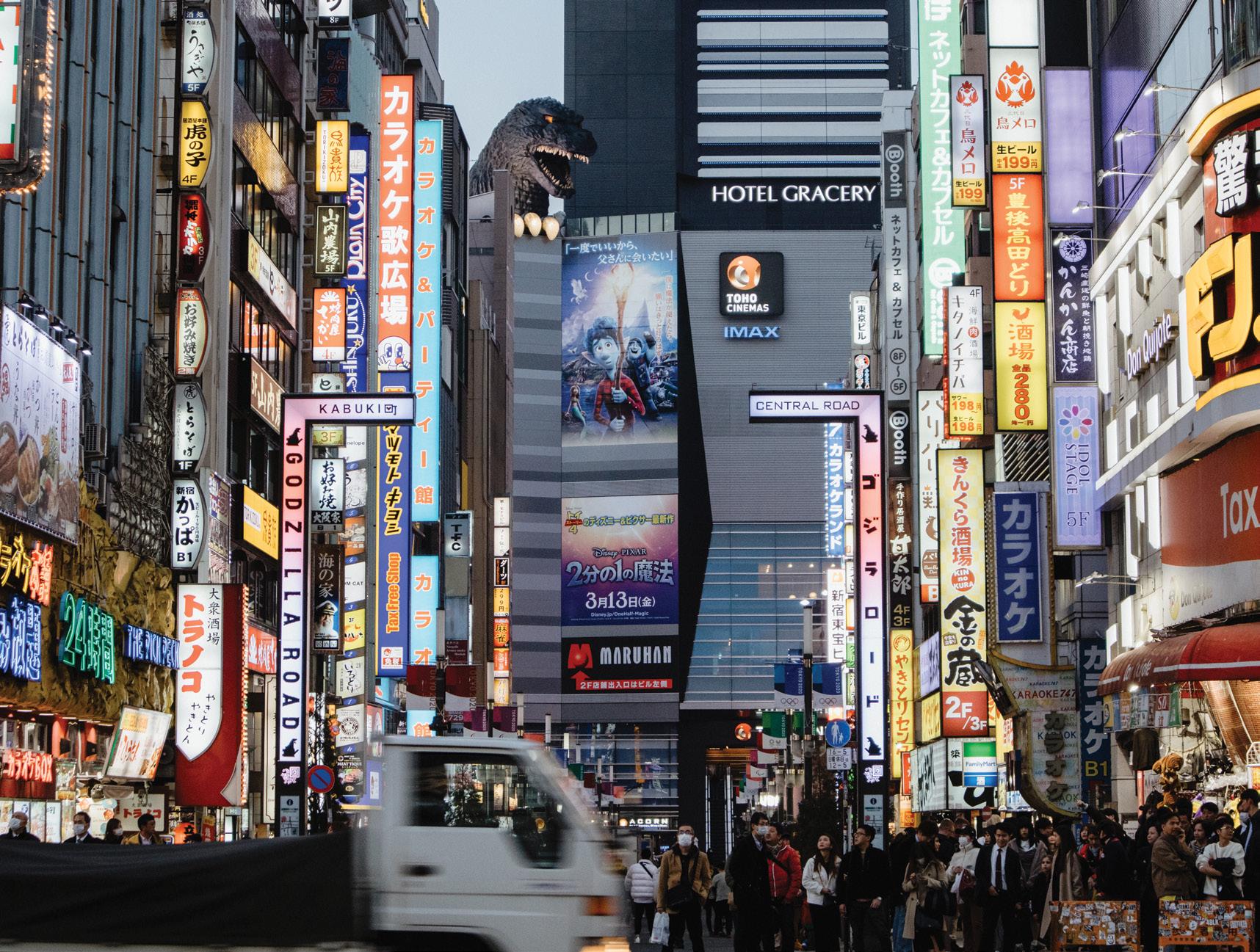
The best Japanese films of the past year—Godzilla Minus One, Perfect Days and The Boy and the Heron —inspire a fascinating tour of its capital. / by BENJAMIN EPSTEIN /
TOKYO SKYTREE, THE WORLD’S TALLEST TOWER at more than 2,000 feet…. Shibuya Crossing, the world’s busiest pedestrian intersection…. Senso-Ji, the city’s oldest temple, completed in the year 645…. These are typical attractions on Tokyo itineraries.
But lovers of cinema might prefer a particularly timely agenda inspired by this past year’s top Japanese films.
Godzilla Minus One, highest-grossing Japanese live-action film ever in the U.S.—and the best in the
franchise’s 70-year history—took home this year’s Oscar for Best Visual Effects. Takashi Yamazaki was responsible for those effects, as well as writing and directing.
For many, Godzilla Minus One is a more poignant and relatable commentary on nuclear holocaust than Best Picture winner Oppenheimer. The embodiment of Japanese fears about nuclear weapons following the bombings of Hiroshima and Nagasaki, Godzilla is among the most potent symbols/metaphors in film history.

Tokyo’s landmark Godzilla head, “life-sized” at 40 feet high, looms over the Shinjuku Toho Building. Though recently closed for maintenance and construction, you could touch the head on
the eighth-floor terrace of the Hotel Gracery Shinjuku, which also has Godzilla-themed rooms.
Hokusai’s The Great Wave Off Kanagawa joins Godzilla on pens, T-shirts and note cards at Godzilla

Store Tokyo, at nearby Shinjuku Marui Annex.
Director Wim Wenders is known for masterpieces including Paris, Texas (1984)—in re-release for its 40th anniversary—and Wings of Desire (1987).
Wenders’ new Perfect Days earned the Cannes Film Festival Best Actor award for star/executive producer Koji Yakusho, and was Oscar-nominated for Best International Film. It eclipsed Wenders’ global box office records.

In it, Yakusho plays a cleaner for the Tokyo Toilet—17 architecturally
extraordinary public restrooms by 16 designers in the Shibuya neighborhood (tokyotoilet.jp.en); the film features about half of the locations.

Kengo Kuma describes his secluded Nebeshima Shoto Park project as “a toilet village…. The five huts, each covered with eared cedar board louvers installed at random angles, are connected by a walk in the woods.” Shigeru Ban’s glass-walled wonder at Haru-noOgawa Community Park is transparent when available, opaque when in use.
Studio Ghibli’s The Boy and the Heron—No. 1 at the North American box office earlier this year and likely Japanese master Hayao Miyazaki’s final film—was named Best Animated Feature at both the Academy Awards and the Golden Globes.
Studio Ghibli has produced such landmark animated films as Spirited Away (2001) and Howl’s Moving Castle (2004) and unforgettable characters Totoro and No-Face.
Designed by Miyazaki and described as "portal to a storybook world," the maze-like Mitaka Forest Ghibli Museum in the Tokyo suburbs is one of the city’s hottest tickets. Online tickets sell out instantly; pricier tour operators are an option.
In addition to exhibits on animation art and technique, the venue offers a gift shop, bookstore, cafe, rooftop garden, theater and children’s play area.
“IHAVECHILLSEVERYTIMETHISCHOIRSINGS.”
— SOFIA VERGARA GOLDEN BUZZER WINNER ONNBC’S‘AMERICA’SGOTTALENT’



A SOULFUL BENEFIT CONCE�T PRESENTED BY MUSICPOWER.ORG

OCT 26 5:30PMatEVE
975 WATE�FRONT PL.

Join us for an unforgettable night out at San Diego’s elegant new waterfront venue with stunning Bay views, cocktails at sunset, and music that will feed your soul.
Featuring award-winning musicians, original compositions, and Voices’ internationally acclaimed performance ensemble. Don’t miss out on this unique experience celebrating an organization San Diego Magazine calls “an inspirational nonprofit”.
Voices of Our City amplifies the voices of people impacted by homelessness through music and the arts. All concert proceeds help San Diegans out of homelessness — for good. voicesofourcity.org


CONT’D. FROM PAGE 15 year long in both cities.
future generations.”
World Design Capital
San Diego Tijuana has provided a yearlong platform to showcase design; while further enhancing cross-border collaboration and raising the profile of this binational region on the global stage. Dozens of events—including conferences, performances, exhibitions and activations—have been held all
In August, the Exchange Pavilion was unveiled in Balboa Park’s Plaza de Panama. It was created by Daniel Ruanova, an internationally recognized visual artist from Tijuana; and Heleo, a San Diego architecture and design agency. The curving metal sculpture references the San Diego-Tijuana border wall, but aims to bring people together rather than
separate them. A digital ticker along the edge exhibits poems rather than stock prices.
For the rest of 2024, according to the group, the Exchange Pavilion will serve as a hub for free programming, including lectures, performances, workshops and gatherings that invite visitors to explore, learn and engage— actively participating in




Sep. 11 - Nov. 2



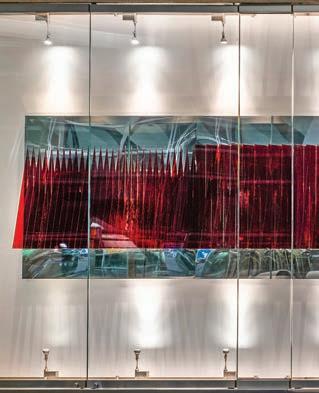
the exchange of ideas, culture and experiences. Among these was a new musical composition written for the youth symphonies of San Diego and Tijuana, who joined at the Pavilion in September to perform it as one group. In October, the Exchange Pavilion will be the site of a community dialogue, “Reimagine Balboa Park,” to discuss an update to the 1989 Balboa Park Master Plan with input from the public.
Scott Robinson—head of design firm FreshForm, and founding president of Design Forward Alliance, which was formed in 2016 to bring WDC to San Diego-Tijuana—says during the process of preparing its bid, the organization realized “you cannot decouple San Diego from


“This is who we are—products of cross-border life. Many people cross the border every day, to work, play, eat, attend sporting events, and so on.”
—Scott Robinson
Tijuana, and we are stronger for it. This is who we are—products of crossborder life. Many people cross the border every

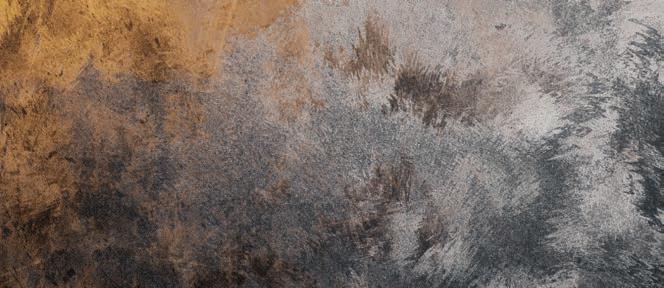




day, to work, play, eat, attend sporting events, and so on. So we made it a part of our application, and the World Design Organization broke its own rules to give two cities the designation for the first time.”
Silva says that attending World Design Capital events in the last designated city, Valencia, Spain, in 2022 made her realize “we have a duty to design for the future. It made me aware that in Tijuana and San Diego, we live in a very specific way that could be an inspiration for other cities.”

Robinson says one of the highlights of the WDC San Diego Tijuana to date was the World Design Festival held in Tijuana in May. With 100 events over five days, many small studios were spotlighted for their designs and creations, from architecture and furniture design to pottery and art; with workshops and presentations that brought in attendees from around the world. “Many had never been to Tijuana



before, and the festival was crucial to changing their perceptions of what a border town is.”
WDC San Diego Tijuana has also been supporting myriad impact projects in different areas on both sides of the border—from science and technology, to arts and culture, to climate and sustainability, and more. Robinson says these projects were set up as experiments to have a catalyzing effect on the region, such as revitalizing 20 acres in Friendship Park, on each side of the border, in an effort to find and foster new forms of connection. “Encouraging activation gives us opportunities to express and share positivity and fight the negative border town stereotypes,” he says.
In addition to events at the Exchange Pavilion, other WDC San Diego Tijuana events this



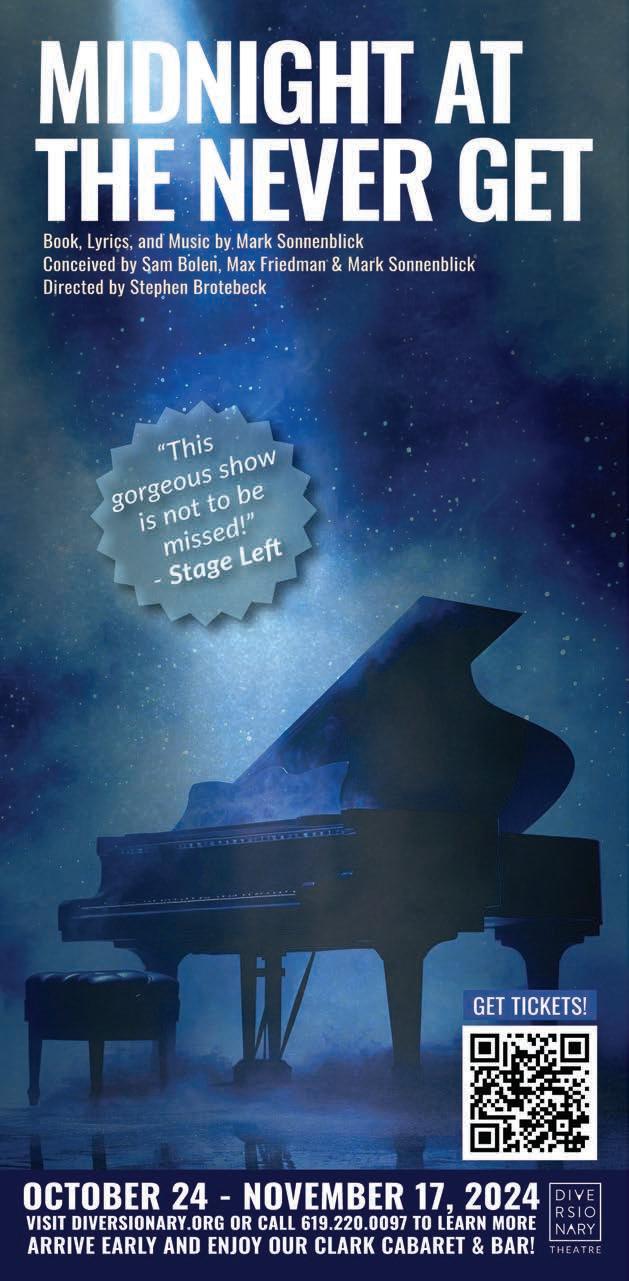
FEATURE

Barbara Leon of Heleo Architecture + Design
“We have a duty to design for the future. It made me aware that in Tijuana and San Diego, we live in a very specific way that could be an inspiration for other cities.”
Katalina Silva
month include the firstever San Diego-Tijuana International Jazz Festival, to be held at the California Center for the Arts, Escondido on Oct. 4; the Tijuana Jazz and Blues Festival on Oct. 5; and continuing at the Quartyard in East Village on Oct. 6. Featured artists who will perform on both sides of the border include Magos Herrera with the Hausmann Quartet;




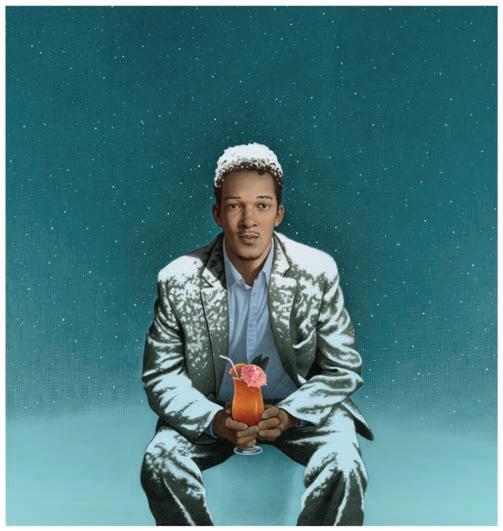







Gilbert Castellanos’ All-Star Sextet; and a Youth Ensemble consisting of San Diego’s acclaimed Young Lions Jazz Conservatory and the Instituto Contemporáneo de Música de Baja California. Slated for Oct. 8-10, the 21st International Congress “Designing for Humanity/ Future” will take place at the Universidad Anáhuac México, at which design is considered through the light of other disciplines. These are just a few of dozens of events on the WDC 2024 schedule. Coming up is “Beyond Boundaries,” a World Design Policy Conference at UC San Diego in La Jolla, Nov. 12–13. This two-day event hosted by the UC San Diego Design Lab and the City of San Diego will feature panel discussions, workshops and a speaker series with the goal of shaping the future of urban living and








design policies. Then, on Nov. 16, the WDC 2024 Convocation Ceremony at the Salk Institute in La Jolla will celebrate the year’s achievements; and then pass the torch to Frankfurt Rhine-Main, Germany, which will host WDC in 2026.
“It’s a real awareness moment for the region,” says Silva. “We’re hoping participating in these events will help the general public see how to approach problems with a different perspective, a creative perspective—an opportunity to collaborate and enhance a possible future.”





“We look at WDC 2024 as the beginning of something, like the Panama–California Exposition in 1915 that led to the creation of Balboa Park,” says Robinson. “It’s intended to be the start of a dialogue that allows the region to thrive and flourish in the future. What might the future be for this region—more collaborative, more thoughtful and intentional. If we start conversations now and put design at the forefront, that’s what design can do.”
For more info on World Design Capital and the full calendar of 2024 events in Tijuana and San Diego, please visit: wdc2024.org
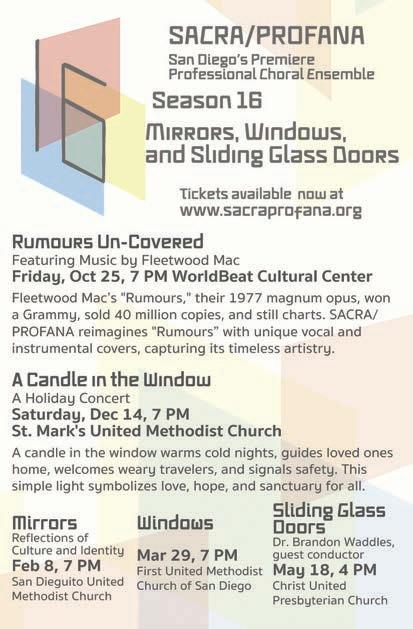

bachcollegiumsd.org







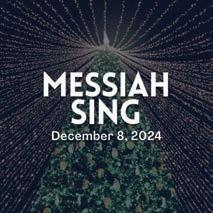


DROP DOWN MENU Table of app contents.
REGISTER
Stay arts-engaged, access past programs.
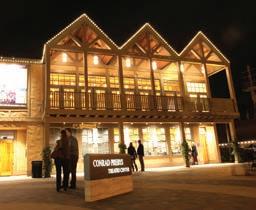
THE ESSENTIALS Acts, scenes, synopses, repertory and notes.
CONTRIBUTORS
Donors and sponsors who make it all possible—you!

NO RUSTLING PAGES, no killing trees . . . The new Performances program platform, accessed on any digital device, is among the more enduring innovations to have come out of the pandemic. The platform provides the programs for 20 Southern California performing-arts organizations, from the Los Angeles Philharmonic and Ahmanson Theatre to San Diego Opera, where the app made its debut.
The touchless platform provides cast and player bios, donor and season updates and numerous other
arts-centric features. Audiences receive a link and a code word that instantly activate the app; QR codes are posted, too.
Screens go dark when curtains go up and return when house lights come back on. Updates—such as repertory changes, understudy substitutions and significant new donations—can be made right up to showtime, no inserts necessary. Other features include video and audio streams, translations and expanded biographies.
For those who consider printed
SEARCH
Find whatever it is you want to know—easily.
SIGN IN
Link to your performing-arts companies and venues.
THE PLAYERS
Bios and background for cast, crew and creators.
WHAT’S ON
What’s coming at a glance and ticket information.
programs to be keepsakes, a limited number, as well as commemorative issues for special events, continue to be produced. Collectibles!
Meanwhile, there is less deforestation, consumption of petroleum inks and programs headed for landfills. For the ecologically minded, the platform gets a standing ovation.
When theaters and concert halls reopened after their long intermission, the digital Performances was but one more reason for audience excitement. Activate your link and enjoy the shows. —CALEB WACHS


